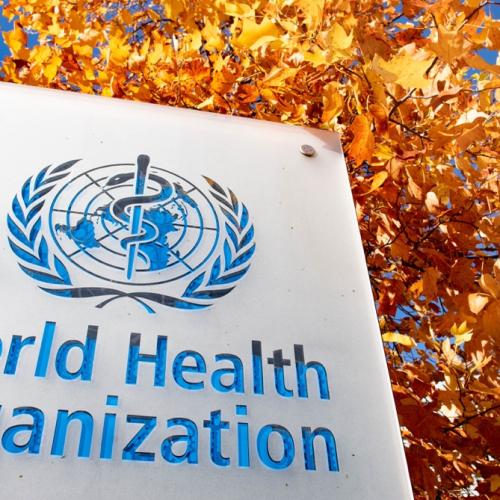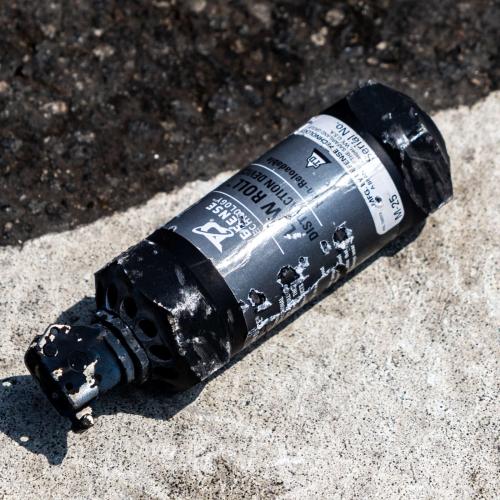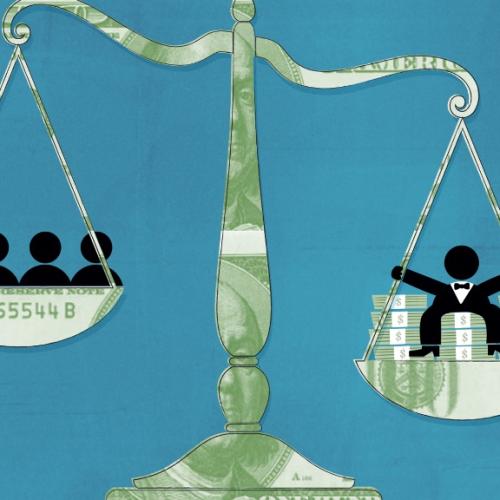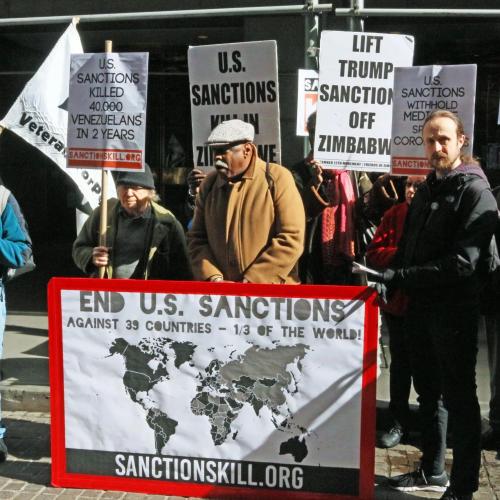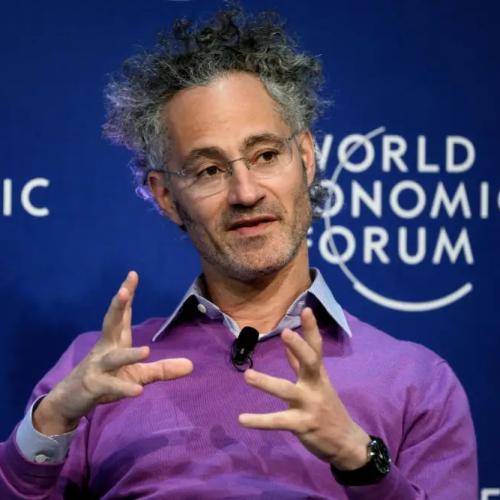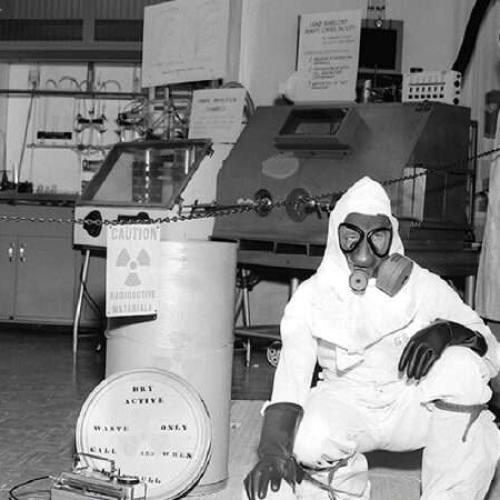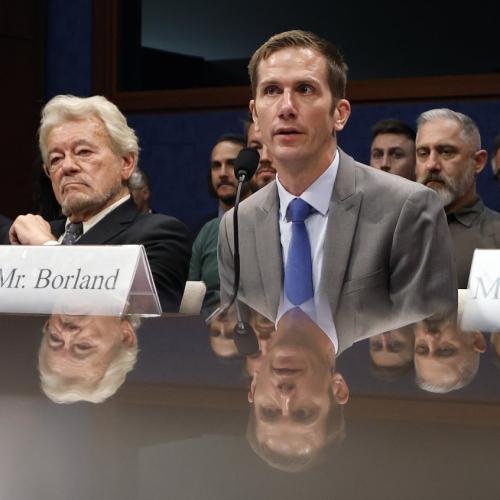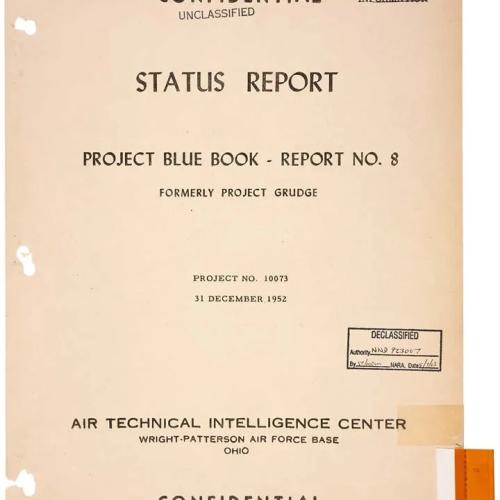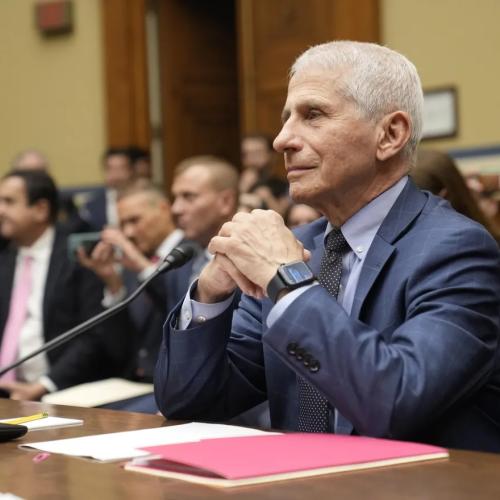Global Warming News Stories
Below are key excerpts of revealing news articles on global warming from reliable news media sources. If any link fails to function, a paywall blocks full access, or the article is no longer available, try these digital tools.
As scientists who have worked on the science of solar geoengineering for decades, we have grown increasingly concerned about the emerging efforts to start and fund private companies to build and deploy technologies that could alter the climate of the planet. The basic idea behind solar geoengineering, or what we now prefer to call sunlight reflection methods (SRM), is that humans might reduce climate change by making the Earth a bit more reflective, partially counteracting the warming caused by the accumulation of greenhouse gases. Many people already distrust the idea of engineering the atmosphere—at whichever scale—to address climate change, fearing negative side effects, inequitable impacts on different parts of the world, or the prospect that a world expecting such solutions will feel less pressure to address the root causes of climate change. Notably, Stardust says on its website that it has developed novel particles that can be injected into the atmosphere to reflect away more sunlight, asserting that they’re “chemically inert in the stratosphere, and safe for humans and ecosystems.” But it’s nonsense for the company to claim they can make particles that are inert in the stratosphere. Even diamonds, which are extraordinarily nonreactive, would alter stratospheric chemistry. Any particle may become coated by background sulfuric acid in the stratosphere. That could accelerate the loss of the protective ozone layer.
Note: Modifying the atmosphere to dim the sun involves catastrophic risks. Regenerative farming is far safer and more promising for stabilizing the climate. In our latest Substack, "Geoengineering is a Weapon That's Been Rebranded as Climate Science. There's a Better Way To Heal the Earth," we present credible evidence and current information showing that weather modification technologies are not only real, but that they are being secretly propagated by multiple groups with differing agendas.
Deflecting the sun to fight climate change could trigger droughts and hurricanes, the Royal Society has warned. In a new report, experts argued solar radiation modification (SRM) could reduce global temperatures but “worsen rather than ease” climate change and make the sky look less blue. In May, the Government’s Advanced Research and Invention Agency (Aria) announced £56.8m for 21 “climate cooling” projects, which include injecting aerosols into the sky to reflect sunlight away from Earth. However, the report found there were “major uncertainties” and argued the plan may have devastating knock-on effects, particularly if deployed by rogue groups. Prof Jim Haywood, of atmospheric science at the University of Exeter, said: “What you do in one place can cause climate change in a different place. “Stratospheric aerosol injection deployment in the northern hemisphere could impact the position of the tropical monsoon and lead to droughts in sub-Saharan Africa. “Everyone there relies on subsistence farming, so it quickly devastates if there is a drought there. “In the southern hemisphere, it could lead to an increase in North Atlantic hurricane frequency and intensity, it could lead to winter droughts over the Mediterranean and the Iberian Peninsula.” A “termination effect” whereby sun dimming technology was suddenly stopped, could also lead to rapid warming of up to 2C in decades, and cause devastating effects for ecosystems.
Note: Modifying the atmosphere to dim the sun involves catastrophic risks. Regenerative farming is far safer and more promising for stabilizing the climate. In our latest Substack, "Geoengineering is a Weapon That's Been Rebranded as Climate Science. There's a Better Way To Heal the Earth," we present credible evidence and current information showing that weather modification technologies are not only real, but that they are being secretly propagated by multiple groups with differing agendas.
Last year, a climate scientist named Patrick Brown, along with seven co-authors, published a study in the journal Nature about the connections between wildfires in California and global warming. Dr. Brown confessed in a Free Press article that he had framed his research not just to reflect the truth, but to fit within what he described as the climate alarmist storyline preferred by prestigious journals in the United States. He did this, he says, by intentionally focusing only on climate as a factor in wildfires, and not on the myriad other causes that contribute to the blazes consuming ever more land across the country. The formula for getting published, he wrote, “is more about shaping your research in specific ways to support pre-approved narratives than it is about generating useful knowledge for society.” And when it comes to climate science, he alleged, that preapproved narrative is that “climate change impacts are pervasive and catastrophic.” [Climate scientist] Dr. Pielke argues that many of the widely cited cost estimates connecting weather disasters to climate change are mistaken. (Climate advocates regularly assert that climate change is costing the U.S. billions of dollars every year.) His research, he says, shows that extreme weather appears costlier because properties are more valuable. In other words, wealth increase is the real story. He regularly takes issue with media portrayals of extreme weather. The reality is more complex, he says. If climate science doesn’t make space for alternative viewpoints, it risks its foundational ideals of open inquiry and debate and rigorous, evidence-based critiques,
Note: For more along these lines, read our concise summaries of news articles on climate change and corruption in science.
For years, the Intergovernmental Panel on Climate Change, or IPCC, has claimed that human-caused climate change has accelerated sea level rise. But that claim is false. This does not mean that climate change isn’t happening. It is. It simply means that it has not caused the sea level to rise. Top scientists know this fact and have deliberately misrepresented it for years, deceiving the public. In September, I reported on one of the first global studies of sea level rise that used tide-gauge data, which is the only real-world data that goes back long enough, to the mid-19th Century, that would allow one to detect whether sea level rise had accelerated, decelerated, or remained steady. The only reliable long-term real-world data is tide gauge data, and they do not show acceleration. Since then, I exchanged over 50 emails with one of the world’s leading sea level rise scientists, Robert Kopp from Rutgers University, and heard back from IPCC, NASA, and NOAA, the National Oceanic and Atmospheric Administration. What I learned shocked me. For years, the world’s top scientists have known that they cannot prove there has been an acceleration of sea level rise, and yet they have told the public that they can. We’ve known since 2018 that 89% of the atoll islands that scientists and the media claimed would be destroyed by sea level rise had instead grown or stayed the same size. Sea level rise is not “observably accelerating” over time horizons that would show a trend. The only scientific basis for claiming it is accelerating is through modeling. The observable tide-gauge data do not show this.
Note: For more along these lines, read our concise summaries of news articles on climate change and corruption in science.
The urban tree canopy in Denver is one of the sparsest in the country. In 2020, when Linda Appel Lipsius became executive director of the decades-old Denver Urban Gardens (DUG) network, which oversees more than 200 community vegetable gardens throughout six metro Denver counties, she wanted to continue increasing community access to fresh food—a longtime goal of the garden program. But she had another aim, too: increasing the city’s tree coverage. Appel Lipsius decided to build a system of food forests throughout the Denver area. These dense, layered plantings incorporate fruit-bearing trees with other perennials to mimic natural forests. Now, DUG oversees 26 food forests, with 600 or so fruit and nut trees and 600 berry bushes. While urban trees are recognized for their multiple benefits, including cooling and carbon drawdown, “there are not a lot of players in Denver, or even in most cities around the country, who are focused on food trees,” Appel Lipsius said. “We were able to step into this space to help build and bolster the canopy while adding food-producing perennials.” Neighbors are welcome to enter and harvest a wide assortment of fruits, nuts, and berries. Beyond providing fresh food in neighborhoods that need it most, these agroforests reduce the urban heat island effect, create pollinator habitat, and combat pollution and climate change by absorbing and filtering harmful gases.
Note: Explore more positive stories like this on healing the Earth.
There are 34 ingredients in M&Ms, and, according to Mars, the company that produces the candy, at least 30 countries – from Ivory Coast to New Zealand – are involved in supplying them. Each has its own supply chain that transforms the raw materials into ingredients – cocoa into cocoa liquor, cane into sugar, petroleum into blue food dye. The environmental impact of ultra-processed foods – like M&Ms – is less clear and is only now starting to come into focus. One reason they have been so difficult to assess is the very nature of UPFs: these industrially made foods include a huge number of ingredients and processes to put them together, making it nearly impossible to track. Since 1850, agricultural expansion has driven almost 90% of global deforestation, which has been responsible for 30% of global greenhouse gas emissions. Getting an exact measure of the environmental toll of UPFs is nearly impossible, given that, definitionally, UPFs consist of many ingredients and a high volume of opaque processes. Ingredients aren’t just mixed together like one would do to make a stew at home. Instead, these ingredients are chemically modified, some parts stripped away, and flavors, dyes or textures added in – and it’s unclear what the cost of these processes are because so many suppliers and components are involved. Another reason is that all UPFs (again, definitionally) are the creations of food companies that have little incentive to disclose their environmental footprint.
Note: For more along these lines, read our concise summaries of news articles on food system corruption and climate change.
Each planting season, Claudia Bashian-Victoroff ventures out into Bole Woods. Laced throughout, weaving an intricate, microscopic web, are the mycorrhizal fungi she’s after — fungi that have spent 400 million years learning to live in symbiosis with plants, including the trees throughout Bole Woods and at least 80 percent of all species on the planet. Bashian-Victoroff doesn’t need much soil. A single spoonful can contain miles of fungal hyphae and filaments, engaged in an ancient evolutionary exchange with the trees to which they’ve bonded. The fungi gather up water and nutrients, and deliver them to the trees. In return, they receive carbohydrates developed through photosynthesis, which they fix into the soil as they grow. It’s a prosperous cycle, and Bashian-Victoroff is among a growing global community of researchers and conservationists taking advantage of this relationship to restore forests and other degraded ecosystems. Their goal: Promote the health of the soil beneath our feet and the plants it supports, sequester carbon and make agriculture more sustainable. Mycorrhizal fungi can be an important part of a broader suite of climate solutions, says Anne Polyakov, a fungal conservation and restoration scientist with the Society for the Protection of Underground Networks, or SPUN, which recently used machine learning to map the planet’s mycorrhizal networks in an effort to promote conservation.
Note: Explore more positive stories like this in on technology for good and healing the Earth.
Emerging in the 1950s, preppers were animated by a variety of often overlapping fears: some were troubled by the increasingly networked, and therefore fragile, nature of contemporary life. Early adopters ... went off-grid; hoarded provisions, firearms and ammunition, and sometimes constructed hidden bunkers. They championed individual fortitude over collective welfare. Not all of them are conservatives. Liberals make up about 15% of the prepping scene, according to one estimate, and their numbers appear to be growing. Some ... [are] steeped in the mutual aid framework of the anarchist philosopher Peter Kropotkin: a rejection of individualism and an emphasis on community building and mutual aid. The question is less whether we survive than how we maintain our humanity in the face of calamity, how we cope with loss, and how we use the time we have. Elizabeth Doerr, co-host of the Cramming for the Apocalypse podcast, agreed: “Researchers talk a lot about how your ability to survive a disaster or thrive post-disaster is contingent on really knowing your neighbors – because when they don’t see you, they’re gonna come check on you.” Rather than an effort to defend ... against a nightmare future, it’s a part of a commitment to living meaningfully in the present. Genuine prepping requires not only “outer resilience”, as [community organizer David] Baum puts it, but an inner kind as well. “Survival is not the goal,” he told me afterward. “The relationship and the wisdom and the love that one discovers by approaching nature with respect – that’s the goal.”
Note: For more along these lines, read our concise summaries of news articles on climate change and healing social division.
In July 2012, a renegade American businessman, Russ George, took a ship off the coast of British Columbia and dumped 100 tons of iron sulfate dust into the Pacific Ocean. He had unilaterally, and some suggest illegally, decided to trigger an algae bloom to absorb some carbon dioxide from the atmosphere—an attempt at geoengineering. Now a startup called Stardust seeks something more ambitious: developing proprietary geoengineering technology that would help block sun rays from reaching the planet. Stardust formed in 2023 and is based in Israel but incorporated in the United States. Geoengineering projects, even those led by climate scientists at major universities, have previously drawn the ire of environmentalists and other groups. Such a deliberate transformation of the atmosphere has never been done, and many uncertainties remain. If a geoengineering project went awry, for example, it could contribute to air pollution and ozone loss, or have dramatic effects on weather patterns, such as disrupting monsoons in populous South and East Asia. Stardust ... has not publicly released details about its technology, its business model, or exactly who works at its company. But the company appears to be positioning itself to develop and sell a proprietary geoengineering technology to governments that are considering making modifications to the global climate—acting like a kind of defense contractor for climate alteration.
Note: Regenerative farming is far safer and more promising than geoengineering for stabilizing the climate. For more along these lines, read our concise summaries of news articles on geoengineering and science corruption.
While attempting to control the weather might sound like science fiction, countries have been seeding clouds for decades to try to make rain or snow fall in specific regions. Invented in the 1940s, seeding involves a variety of techniques including adding particles to clouds via aircraft. It is used today across the world in an attempt to alleviate drought, fight forest fires and even to disperse fog at airports. In 2008, China used it to try to stop rain from falling on Beijing’s Olympic stadium. But experts say that there is insufficient oversight of the practice, as countries show an increasing interest in this and other geoengineering techniques as the planet warms. The American Meteorological Society has said that “unintended consequences” of cloud seeding have not been clearly shown — or ruled out — and raised concerns that unanticipated effects from weather modification could cross political boundaries. And there have been instances when cloud seeding was used deliberately in warfare. The United States used it during “Operation Popeye” to slow the enemy advance during the Vietnam War. In response, the UN created a 1976 convention prohibiting “military or any other hostile use of environmental modification techniques”. A number of countries have not signed the convention. Researcher Laura Kuhl said there was “significant danger that cloud seeding may do more harm than good”, in a 2022 article for the Bulletin of the Atomic Scientists.
Note: Regenerative farming is far safer and more promising than geoengineering for stabilizing the climate. For more along these lines, read our concise summaries of news articles on geoengineering and science corruption.
More than a dozen private companies around the world are looking to profit from extreme measures to combat global warming — filling the sky with sunlight-blocking particles, brightening clouds or changing the chemistry of the oceans. The problem is that nobody knows how to control the unintended consequences. Some scientists who’ve studied and modeled the complexity of Earth’s oceans and atmosphere say any “geoengineering” scheme big enough to affect the climate could put people at risk of dramatic changes in the weather, crop failures, damage to the ozone layer, international conflict and other irreversible problems. Environmental lawyer David Bookbinder is more afraid of geoengineering than he is of climate change. “The consequences of geoengineering could happen a lot faster and with much less warning,” he said. He said the world lacks the legal or regulatory framework to ensure no single government or private entity takes a risky initiative. At the same time, “there’s a clamor for tech solutions.” Mark Z. Jacobson, an atmospheric modeler ... said we’ve already seen the results of several natural experiments. Some forms of air pollution have been cooling the planet by about 1 degree C, but that same pollution also kills millions of people from respiratory illnesses. In 1815, the eruption of Tambora injected so many particles into the atmosphere that 1816 was dubbed “the year without a summer.” People died from crop failure and famine.
Note: Regenerative farming is far safer and more promising than geoengineering for stabilizing the climate. For more along these lines, read our concise summaries of news articles on geoengineering and science corruption.
In the past few years, the number of rocket launches has spiked as commercial companies — especially SpaceX, founded by Elon Musk — and government agencies have lofted thousands of satellites into low-Earth orbit. And it is only the beginning. Satellites could eventually total one million, requiring an even greater number of space launches that could yield escalating levels of emissions. Scientists worry that more launches will scatter more pollutants in pristine layers of Earth’s atmosphere. And regulators across the globe, who assess some risks of space launches, do not set rules related to pollution. Experts say they do not want to limit the booming space economy. But they fear that ... we may understand the consequences of pollution from rockets and spacecraft only when it is too late. Already, studies show that the higher reaches of the atmosphere are laced with metals from spacecraft that disintegrate as they fall back to Earth. In a paper published in 2022, soot from rockets was shown to be nearly 500 times as efficient at heating the atmosphere as soot released from sources like airplanes closer to the surface. A separate study also published in 2022 found that if the rate of rocket launches increased by a factor of 10, their emissions could cause temperatures in parts of the stratosphere to rise as much as 2 degrees Celsius. This could begin to degrade the ozone over most of North America, all of Europe and a chunk of Asia.
Note: The risks posed by satellites expand beyond emissions. For more along these lines, see concise summaries of deeply revealing news articles on climate change from reliable major media sources.
The solution to stopping climate change might be buried on 10 acres in the Pauma Valley of California. “The idea is not just to produce food but to improve the soil,” says Alvarez, Solidarity Farm’s Climate Resilience Specialist. “We stopped using the plow to turn the soil, and we do a lot of composting and mulching to improve our soil health.” Solidarity Farm had used organic principles in the 10 years since its inception, but it pivoted to carbon farming after the extreme heat in the summer of 2017. Carbon farmers cultivate plants and trees in a way that maximizes carbon sequestration in the soil. Among the most important practices for carbon farmers are minimizing soil erosion by planting perennials and ground cover, which also lowers soil temperatures, and only working the land by hand or with low-tech solutions. “The soil has the capacity to store more carbon than all plants on the planet together,” Alvarez says. Solidarity Farms produces a diverse range of about 60 different fruits and vegetables, at least 70 percent of them perennial crops such as plums and pomegranates. Stacks of organic chicken manure in front of the vegetable beds wait to be distributed. The farmers enrich the soil with compost and mulch, while deterring pests with diverse crop rotation. According to soil tests, the Solidarity farmers have tripled the amount of carbon in the ground since 2018. “This equates to a drawdown of nearly 600 metric tons of CO2 per year, offsetting the emissions of 80 American households,” Alvarez says.
Note: Have you seen the groundbreaking and inspiring movie Kiss the Ground? In a time where we're told hopeless and divisive narratives about our current environmental challenges, people all over the world are reversing the damage from destroyed ecosystems, regenerating the world's soils, and creating abundant food supplies. Don't miss this powerful film on the growing regenerative agriculture movement and its power to revive global community and our connection to the natural world.
When Anthony Myint and his wife Karen Leibowitz opened their San Francisco restaurant The Perennial in 2016, they had big ambitions: They wanted it to be the first carbon-neutral restaurant in the world, and they succeeded. From the recycled floor tiles and reclaimed lumber to the aquaponic herb garden and compostable paper menus, the culinary duo designed every part of the diner with the climate in mind. “We shifted the menus, reduced food waste, switched to renewable energy, started composting and bought carbon offsets,” Myint says. They were motivated by the knowledge that agriculture and food systems contribute nearly a third of greenhouse gas emissions worldwide. The Perennial’s menu championed sourdough loaves baked with perennial Kernza grains, and the chefs bought their steaks from regenerative ranches associated with the Marin Carbon Project, the country’s foremost center for regenerative farming. The more Myint learned about regenerative agriculture, the more he became convinced that this was the global solution he needed to champion. “It became clear to me that this is the future of food, similar to the way renewable energy is the future of energy,” he says. “The whole food system needs to gradually transition.” Zero Foodprint is asking restaurant customers and other participating businesses to give one percent of their sales to a pool that funds regenerative agriculture. More than 80 businesses have signed up.
Note: We've summarized a handful of stories about the power of regenerative agriculture practices to reverse and heal global ecological destruction. Explore more positive stories like this in our comprehensive inspiring news articles archive focused on solutions and bridging divides.
Carbon credit speculators could lose billions as scientific evidence shows many offsets they have bought have no environmental worth and have become stranded assets. Amid growing evidence that huge numbers of carbon credits do nothing to mitigate global heating and can sometimes be linked to alleged human rights concerns, there is a growing pile of carbon credits ... that are unused in the unregulated voluntary market, according to market analysis. Many of the largest companies in the world have used carbon credits for their sustainability efforts from the unregulated voluntary market, which grew to $2bn (£1.6bn) in size in 2021 and saw prices for many carbon credits rise above $20 per offset. The credits are often generated on the basis they are contributing to climate change mitigation such as stopping tropical deforestation, tree planting and creating renewable energy projects. A new study in the journal Science has found that millions of forest carbon credits approved by Verra, the world’s leading certifier, are largely worthless and could make global heating worse if used for offsetting. The analysis ... found that 18 big forest offsetting projects had produced millions of carbon credits based on calculations that greatly inflated their conservation impact. The schemes, which generate credits by avoiding hypothetical deforestation, were found not to reduce forest loss or to reduce it by only small amounts, far less than the huge areas they were claiming to protect, rendering the credits largely hot air.
Note: For more along these lines, see concise summaries of deeply revealing news articles on financial industry corruption and climate change from reliable major media sources.
A number of Indigenous communities in the Amazon say that “carbon pirates” have become a threat to their way of life as western companies seek to secure deals in their territories for offsetting projects. Across the world’s largest rainforest, Indigenous leaders say they are being approached by carbon offsetting firms promising significant financial benefits from the sale of carbon credits if they establish new projects on their lands, as the $2bn (£1.6bn) market booms with net zero commitments from companies in Europe and North America. Proponents of carbon markets, especially those that aim to protect rainforests, say that carbon credits are a good way to fund the new areas and pay Indigenous communities for the stewardship of their lands. The resulting credits could then be used for climate commitments by western companies. Indigenous communities are being taken advantage of in the unregulated sector, with opaque deals for carbon rights that can last up to a century, lengthy contracts written in English, and communities being pushed out of their lands for projects. Examples include Peru’s largest ever carbon deal involving an unnamed extractive firm, where the Kichwa community claim they have been forced from their land in Cordillera Azul national park and received nothing from the $87m agreement. Several Indigenous communities spoke of training themselves in carbon market regulation and organising global exchanges to help others avoid falling victim to “carbon pirates”.
Note: An excellent investigation reveals that over 90% of rainforest offsets are likely to be “phantom credits” and do not represent real carbon reductions, yet are being used by Disney, Shell, Gucci, Salesforce, the band Pearl Jam, and other large corporations. For more along these lines, see concise summaries of deeply revealing news articles on climate change from reliable major media sources.
The White House has set into motion a five-year outline for research into “climate interventions”. Those include methods such as sending a phalanx of planes to spray reflective particles into the upper reaches of the atmosphere, in order to block incoming sunlight from adding to rising temperatures. Previous attempts at running experiments for what is known as solar radiation management (SRM) have faced staunch opposition. Last year, an exploratory flight in Sweden of a high-altitude SRM balloon, led by Harvard University researchers, was halted after objections by environmentalists and Indigenous leaders. This prospect horrifies opponents of solar geoengineering. An open letter signed by more than 380 scientists demands a global non-use agreement for SRM; it also says that growing calls for research in this area are a “cause for alarm”, due to an unknown set of ramifications that will have varying consequences in different parts of the world and could scramble “weather patterns, agriculture and the provision of basic needs of food and water”. Frank Biermann, an expert in global governance ... said he’s also disturbed that solar geoengineering will create a sort of moral hazard where governments ease off efforts to cut emissions and fossil fuel companies use it as cover to continue business as usual. There isn’t any international governance around solar geoengineering. Unilateral action to alter the climate could spark conflict if one part of the world benefits, while another suffers.
Note: There is much controversy around geoengineering, yet there is considerable evidence that reveals the possibility of its many applications. For more along these lines, explore revealing media articles on geoengineering and HAARP (High Frequency Active Auroral Research Program), a little-known U.S. military defense project that conducted investigations into weather control technologies, among many other concerning explorations.
Global capitalism is an incredible machine for extracting fossil fuels from our planet, refining them, shipping them to every corner of the Earth and making staggering amounts of money doing so. Unfortunately the machine is also poisoning us all. But one of its exquisitely evolved functions is to make it almost impossible to turn it off. Oil and gas profits in the most recent quarter were astounding. Exxon Mobil made $18bn in profits in the past three months. Shell and Chevron each made nearly $12bn. Those are all record numbers. A recent study showed that for the past 50 years, the oil industry has made profits of more than $1tn a year, close to $3bn a day. These profits are driven [by] cartels, mega-corporations and the regulatory capture of governments, conspiring to create a market free of both competition and of a price that reflects the actual cost to the world of the product that is being sold. These profits are illusory. They are plagued by an externality large enough to outweigh a trillion dollars a year – the costs that the climate crisis will impose on billions of people who are alive now and many generations to come. The fossil fuel industry as a whole is not just another business, providing a service to meet a demand; it is a predatory drug dealer that works every day to keep the world addicted to its poisonous product, knowing full well that it will eventually prove fatal. It fights to keep the population fooled. It is a problem to be solved.
Note: For more along these lines, see concise summaries of deeply revealing news articles on corporate corruption and climate change from reliable major media sources.
China has reduced air pollution nearly as much in seven years as the US did in three decades, helping to bring down average global smog levels in the process. The amount of harmful particulates in the air in China fell 40% from 2013 to 2020, according to the University of Chicago’s Energy Policy Institute, which would add about two years to average life expectancy if sustained. While smog in large swathes of the country still significantly exceeds safe levels, its experience shows how quickly progress can be made, researchers including Professor Michael Greenstone said in a report. About 97% of the world’s population live in areas where air quality is usually worse than World Health Organization guidelines, according to the researchers. Smog reduces global life expectancy more than cigarette smoking, alcohol or poor sanitation. “China’s success in reducing pollution is a strong indication of the opportunities that could lie ahead for other nations if they were to impose strong pollution policies,” they said. Even in the US and Europe ... more than 90% of people live in areas that don’t meet WHO guidelines, which were tightened last year. China’s success, led by restrictions on car use and coal burning in major cities, has been rapid, with its 40% decline in seven years nearly equaling a 44% drop in US pollution over 30 years from 1970, after the landmark Clean Air Act was passed. Without China’s declines, the world would have seen average pollution levels increase since 2013 instead of drop.
Note: Explore a treasure trove of concise summaries of incredibly inspiring news articles which will inspire you to make a difference.
The U.N. climate report released Monday presents a major leap forward in predicting how geoengineering to limit global warming might affect the planet, although scientists said the greatest hurdle remains deciding whether to use the controversial methods. Geoengineering involves large-scale interventions that shift the climate, generally with an aim of cooling the earth. The United Nations panel addressed two types of geoengineering in the report - solar radiation management and greenhouse gas removal. Solar radiation management techniques generally control how much sunlight is reflected back out into space. For example, humans could spray sulfate aerosols - tiny reflective particles - into the stratosphere ... to reflect more sunlight back into space, which lowers global temperatures. But sulfate aerosols have the side effect of also lowering average precipitation. While some regions could gain in an artificially cooler world, others could suffer by, for example, no longer having conditions to grow crops.
Note: Chemtrails anyone? Explore evidence that Spain is spraying chemtrails as part of a secret UN program. For more along these lines, see concise summaries of deeply revealing news articles on climate change from reliable major media sources.
In September 2019, Ryanair circulated a series of adverts on TV, radio and online which urged customers to fly with "Europe's Lowest Fares, Lowest Emissions Airline. Everybody knows that when you fly Ryanair you enjoy the lowest fares. But do you know you are travelling on the airline with Europe’s lowest emissions as well?" The Advertising Standards Agency (ASA), the UK's advertising watchdog, banned the campaign several months later after concluding that these claims were misleading. Ryanair is far from the only company to come under fire for making misleading climate claims. Since the Paris Agreement was signed in 2015, there has been a wave of corporate commitments to reduce emissions. But the increase in enthusiasm for climate responsibility has been matched by a rise in concerns that some companies are using advertising and public messaging, with buzzwords such as "carbon neutrality" and "net zero", to try to appear more sustainable than they actually are. This is referred to by some as "greenwashing". Consumers are increasingly seeing through misleading claims and making more complaints about them as a result. Almost 50 complaints are currently pending globally before a court or an advertising standards body, according to a recent report. The ASA plans to release new guidance to ensure adverts don't mislead the public about the environment in 2022. To date, most complaints regarding misleading climate claims are dealt with by watchdogs, rather than taken to court.
Note: For more along these lines, see concise summaries of deeply revealing news articles on corporate corruption and climate change from reliable major media sources.
The world is spending at least $1.8tn (£1.3tn) every year on subsidies driving the annihilation of wildlife and a rise in global heating, according to a new study, prompting warnings that humanity is financing its own extinction. From tax breaks for beef production in the Amazon to financial support for unsustainable groundwater pumping in the Middle East, billions of pounds of government spending and other subsidies are harming the environment, says the first cross-sector assessment for more than a decade. This government support, equivalent to 2% of global GDP, is directly working against the goals of the Paris agreement and draft targets on reversing biodiversity loss, the research on explicit subsidies found, effectively financing water pollution, land subsidence and deforestation with state money. The fossil fuel industry ($620bn), the agricultural sector ($520bn), water ($320bn) and forestry ($155bn) account for the majority of the $1.8tn, according to the report. No estimate for mining, believed to cause billions of dollars of damage to ecosystems every year, could be derived. Lack of transparency between governments and recipients means the true figure is likely to be much higher, as is the implicit cost of harmful subsidies. Last year, an International Monetary Fund report found the fossil fuel industry benefited from subsidies worth $5.9tn in 2020.
Note: For more along these lines, see concise summaries of deeply revealing news articles on government corruption and climate change from reliable major media sources.
The chairman of a House subcommittee is demanding that executives of Exxon Mobil Corp., Shell, Chevron and other major oil and gas companies testify before Congress about the industry's decades-long effort to wage disinformation campaigns around climate change. Representative Ro Khanna, Democrat of California, said Friday he was prepared to use subpoena power to compel the companies to appear before lawmakers if they don't do so voluntarily. The move comes a day after a secretive video recording was made public in which a senior Exxon lobbyist said the energy giant had fought climate science through "shadow groups" and had targeted influential senators in an effort to weaken President Biden's climate agenda. "The video was appalling," Mr. Khanna said in an interview on Friday. He called it the latest evidence of the fossil fuel industry's efforts to "engage in climate denialism and to manipulate public opinion and to exert undue influence in shaping policy in Congress." Mr. Khanna said the House Oversight and Reform Subcommittee on the Environment, which he chairs, will issue letters next week to top executives at Exxon Mobil, Shell, Chevron and other oil and gas companies and trade groups demanding documents and testimony. One major target of the panel's inquiry are dark money groups that have been funded by fossil fuel companies to disseminate falsehoods about climate science and policy solutions. The hearing is expected to be held in the fall.
Note: Learn more in this Washington Post article. For more along these lines, see concise summaries of deeply revealing news articles on corporate corruption and climate change from reliable major media sources.
Bill Gates has never been a farmer. So why did the Land Report dub him “Farmer Bill” this year? Gates’ achievement, according to the report, is that he’s largest private owner of farmland in the US. A 2018 purchase of 14,500 acres of prime eastern Washington farmland – which is traditional Yakama territory – for $171m helped him get that title. In total, Gates owns approximately 242,000 acres of farmland with assets totaling more than $690m. To put that into perspective, that’s nearly the size of Hong Kong and twice the acreage of the Lower Brule Sioux Tribe, where I’m an enrolled member. A white man owns more farmland than my entire Native nation! The relationship to land – who owns it, who works it and who cares for it – reflects obscene levels of inequality and legacies of colonialism and white supremacy in the United States, and also the world. Wealth accumulation always goes hand-in-hand with exploitation and dispossession. Our era is dominated by the ultra-rich ... and a burgeoning green capitalism. And Bill Gates’ new book How to Avoid a Climate Disaster positions himself as a thought leader in how to stop putting greenhouse gases into the atmosphere and how to fund what he has called elsewhere a “global green revolution” to help poor farmers mitigate climate change. What expertise in climate science or agriculture Gates possesses beyond being filthy rich is anyone’s guess. Investment firms are making the argument farmlands will meet “carbon-neutral” targets for sustainable investment portfolios.
Note: For more along these lines, see concise summaries of deeply revealing news articles on income inequality from reliable major media sources.
A group of Harvard scientists plans to tackle climate change through geoengineering by blocking out the sun. The concept of artificially reflecting sunlight has been around for decades, yet this will be the first real attempt at controlling Earth's temperature through solar engineering. The project, called Stratospheric Controlled Perturbation Experiment (SCoPEx), will spend $3 million to test their models by launching a steerable balloon in the southwest US 20 kilometers into the stratosphere. Once the balloon is in place, it will release small particles of calcium carbonate. As scientists, governmental agencies around the world, and environmental groups grow increasingly worried of our collective ability to reduce greenhouse gas emissions and curb climate change, the idea of geoengineering a solution has become more accepted. The ultimate goal is to reduce the warming on Earth. This can be done by reducing greenhouse gas emissions, sucking CO2 from the atmosphere, or limiting the sunlight that reaches Earth's surface. Blocking out sunlight has been controversial in the scientific community. The controversy lies in the inability to fully understand the consequences of partially blocking out sunlight. There remain questions around this method's impact on precipitation patterns, the ozone, and crop yields globally. With funding in part by Microsoft co-founder Bill Gates, the Harvard team will begin to answer the remaining questions.
Note: What is being proposed here is clearly a form of chemtrails. Thankfully, the first scheduled tests of this geoengineering technique have been canceled. For more along these lines, see concise summaries of deeply revealing news articles on climate change from reliable major media sources.
The hole in the Earth’s ozone layer is expected to fully heal within 50 years, climate change experts predict in a new UN report. A fragile shield of gas around the planet, the ozone layer protects animal and plant life from the powerful ultraviolet (UV) rays of the sun. When the ozone layer is weakened, more UV rays can get through, making humans more prone to skin cancer, cataracts and other diseases. Scientists discovered huge damage to the layer in the 1980s and identified chlorofluorocarbons, or CFCs, as the main culprit. CFCs used to be common in refrigerators, aerosol cans and dry-cleaning chemicals, but they were banned globally under the Montreal Protocol of 1987. The decline in CFCs in our atmosphere as a result of those measures now mean the ozone layer is expected to have fully recovered sometime in the 2060s, according to the report by the UN Environment Programme, World Meteorological Organization, European Commission and other bodies. In parts of the stratosphere, where most of the ozone is found, the layer has recovered at a rate of 1-3% per decade since 2000, the authors state. At the recovery rates projected by the UN report, the northern hemisphere and mid-latitude ozone is scheduled to heal completely by the 2030s, followed by the southern hemisphere in the 2050s and polar regions by 2060. Erik Solheim, head of UN Environment, described the Montreal Protocol as “one of the most successful multilateral agreements in history.”
Note: Explore a treasure trove of concise summaries of incredibly inspiring news articles which will inspire you to make a difference.
Companies are launching unprecedented numbers of rockets to put global Wi-Fi and 5G satellites into the sky. 100,000+ satellites, plus drones and balloons, are planned. Industry and government have done little research, claiming the “big sky” can absorb any problems. And the FCC exempts these satellite networks from environmental review. The sun turns oxygen into ozone in the stratosphere, creating the ozone shield which protects the Earth. But rocket exhaust, alumina, water vapor, and black carbon accumulate in the stratosphere and block the sun’s rays, reducing ozone creation. In 2018, Martin Ross, senior project engineer at The Aerospace Corporation, estimated rockets’ black carbon and alumina was 11,000 tons per year. These new mega-constellations require 1000s of additional rocket launches. Severe ozone loss is possible. 253 scientists signed the 2015 International EMF Scientist Appeal, warning the UN and member states of the damage already occurring. Extensive research shows many impacts from this radiation including: increased tumor, cancer, and stroke risk, oxidative stress, increase in free radicals, DNA, neurological, immune, and dermatological damage, heart rhythm disorders ... cognitive problems, headaches, nausea, and links to Alzheimer’s and ADHD. Wildlife, bees, birds, trees, and plants are also harmed. 5G millimeter RF is highly absorbed by the skin’s sweat ducts and the cornea of the eye, and could additionally impact cardiac function.
Note: For more along these lines, see concise summaries of deeply revealing news articles on the risks of wireless technologies from reliable major media sources.
The US is far behind other industrialized nations on environmental performance and now ranks 24th in the world, according to a new analysis by Yale and Columbia universities. Denmark came in first place, followed by Luxembourg and Switzerland. The United Kingdom ranked fourth. The findings come as the Trump administration has continued to weaken environmental protections in a quest to relax rules on industry and expand fossil fuel development which threatens to put the country even further behind its peers. The index ranks 180 countries on 32 performance indicators across 11 categories covering environmental health and ecosystem vitality. The US is near the back of the pack for developed nations. China, which is plagued by poor air quality, has made investments that have helped it climb to 120th place, ahead of Indias 168th-place ranking. The US ranked 15th on climate. It is currently the second-biggest contributor to the climate crisis, after China. Over time, it has put more heat-trapping gases into the atmosphere than any other nation. But Trump has consistently questioned climate science and the severity of the problem. He has vowed to leave an international agreement to curb emissions, which the US joined under President Barack Obama. Other countries have also seen major changes in governance but are nonetheless doing well on climate. In particular, the US scored poorly on protecting water resources and managing its waste.
Note: For more along these lines, see concise summaries of deeply revealing news articles on climate change from reliable major media sources.
Banks with more than $47 trillion in assets, or a third of the global industry, adopted new U.N.-backed responsible banking principles to fight climate change on Sunday that would shift their loan books away from fossil fuels. Deutsche Bank, Citigroup, and Barclays were among 130 banks to join the new framework on the eve of a United Nations summit in New York aimed at pushing companies and governments to act quickly to avert catastrophic global warming. These principles mean banks have to consider the impact of their loans on society not just on their portfolio, Simone Dettling, banking team lead for the Geneva-based United Nations Environment Finance Initiative, told Reuters. Financing for oil, gas and coal projects has come under particular scrutiny as climate scientists step up calls to change the global economys deep reliance on fossil-fuels. The principles, drawn up jointly by U.N. officials and banks, require lenders to: Align their strategies with the 2015 Paris Agreement to curb global warming and U.N.-backed targets to fight poverty called the Sustainable Development Goals, set targets to increase positive impacts and reduce negative impacts on people and the environment, work with clients and customers to encourage sustainable practices, [and] be transparent and accountable about their progress. The principles main backers say the norms will encourage banks to pivot their loan portfolios away from carbon-intensive assets and redirect capital to greener industries.
Note: Explore a treasure trove of concise summaries of incredibly inspiring news articles which will inspire you to make a difference.
When future generations try to understand how the world got carried away around the end of the 20th century by the panic over global warming, few things will amaze them more than the part played in stoking up the scare by the fiddling of official temperature data. Steven Goddards US blog Real Science [shows] how shamelessly manipulated has been one of the worlds most influential climate records, the graph of US surface temperature records published by the National Oceanic and Atmospheric Administration (NOAA). Goddard shows how, in recent years, NOAAs US Historical Climatology Network (USHCN) has been adjusting its record by replacing real temperatures with data fabricated by computer models. The effect of this has been to downgrade earlier temperatures and to exaggerate those from recent decades, to give the impression that the Earth has been warming up much more than is justified by the actual data. In several posts headed Data tampering at USHCN/GISS, Goddard compares the currently published temperature graphs with those based only on temperatures measured at the time. These show that the US has actually been cooling since the Thirties, the hottest decade on record; whereas the latest graph, nearly half of it based on fabricated data, shows it to have been warming at a rate equivalent to more than 3 degrees centigrade per century.
Note: See the graph on the official NASA website in an article written by NASA's famed climate scientist James Hansen et al. in 1999. The article states "during the past century ... in the U.S. the warmest decade was the 1930s and the warmest year was 1934. and "in the U.S. there has been little temperature change in the past 50 years, the time of rapidly increasing greenhouse gases." Then go to this 2018 webpage on the NASA website and click on the link "Annual Mean Temperature Change in the United States." Compare the graph there with the same graph in the 1999 article. The data has been changed to show warming. Lots more in this article and this video.
Antarctic sea ice set another record this past week, with the most amount of ice ever recorded. National Public Radio (NPR) published an article on its website last month claiming, Ten years ago, a piece of ice the size of Rhode Island disintegrated and melted in the waters off Antarctica. Two other massive ice shelves along the Antarctic Peninsula had suffered similar fates. There's no question that unusually warm air triggered the final demise of these huge chunks of ice. NPR failed to mention anywhere in its article that Antarctic sea ice has been growing since satellites first began measuring the ice 33 years ago. Sea ice has been above the 33-year average throughout 2012. Indeed, none of the mainstream media are covering this important story. A Google News search of the terms Antarctic, sea ice and record turns up not a single article on [this]. Page after page of Google News results for Antarctic sea ice record show links to news articles breathlessly spreading fear ... because Arctic sea ice recently set a 33-year low. Sea ice around one pole is shrinking while sea ice around another pole is growing. New data show ice mass is accumulating on the Antarctic continent as well as in the ocean surrounding Antarctica. The new data also add context to sensationalist media stories about declining ice in small portions of Antarctica (see here, for example). The mainstream media frequently publish stories focusing on ice loss in these two areas, yet the media stories rarely if ever mention that ice is accumulating over the larger area of East Antarctica and that the continent as a whole is gaining snow and ice mass.
Note: A look at US government statistics for sea ice concentration shows a gradual decrease in Arctic sea ice over the past 40 years, yet a slight overall increase in Antarctic ice for the same period. Antarctic sea ice coverage peaked in 2012 to it's highest measurement since 1978, when the graph starts. But then three years later it plunges to it's lowest ever. A NASA website and a university website also raise many questions. For more along these lines, see concise summaries of deeply revealing news articles on global warming from reliable major media sources.
After examining climate data extending back nearly 100 years, a team of Government scientists has concluded that there has been no significant change in average temperatures or rainfall in the United States over that entire period. While the nation's weather in individual years or even for periods of years has been hotter or cooler and drier or wetter than in other periods, the new study shows that over the last century there has been no trend in one direction or another. The study, made by scientists for the National Oceanic and Atmospheric Administration was published in the current issue of Geophysical Research Letters. It is based on temperature and precipitation readings taken at weather stations around the country from 1895 to 1987. Dr. Kirby Hanson, the meteorologist who led the study, said ... that the findings concerning the United States do not necessarily "cast doubt" on previous findings of a worldwide trend toward warmer temperatures, nor do they have a bearing one way or another on the theory that a buildup of pollutants is acting like a greenhouse and causing global warming. Several computer models have projected that the greenhouse effect would cause average global temperatures to rise between 3 and 8 degrees Fahrenheit in the next century.
Note: Watch an intriguing video suggesting the climate data has been tampered with by government agencies to show more warming over the long run than is actually the case. For more along these lines, see concise summaries of deeply revealing climate change news articles from reliable major media sources.
Researchers with UC San Diegos Scripps Institution of Oceanography and Princeton University have walked back scientific findings published last month that showed oceans have been heating up dramatically faster than previously thought as a result of climate change. In a paper published Oct. 31 in the journal Nature, researchers found that ocean temperatures had warmed 60% more than outlined by the United Nations Intergovernmental Panel on Climate Change. However, the conclusion came under scrutiny after mathematician Nic Lewis, a critic of the scientific consensus around human-induced warming, posted a critique of the paper. A quick review of the first page of the paper was sufficient to raise doubts as to the accuracy of its results, [Lewis wrote]. Coauthor Ralph Keeling, a climate scientist at the Scripps Institution of Oceanography, took full blame. Keeling said he and his colleagues have redone the calculations, finding the ocean is still likely warmer than the estimate used by the IPCC. A correction has been submitted to the journal Nature.
Note: Climate change is possibly the most politicized topic out there. Both sides have exaggerated their claims so much that it's hard to know what is really true, other than that global warming is a reality in most parts of the planet. For more along these lines, see concise summaries of deeply revealing science corruption news articles from reliable major media sources.
Carbon-dioxide emissions from electricity generation fell last year to their lowest level since 1987, the U.S. Energy Information Administration reported today, and the strongest driver is neither the shift from coal to natural gas nor the growth of renewables. More than half of the decline in emissions has occurred because of ... a decline in industrial demand for electricity, the EIA reported. "U.S. electricity demand has decreased in 6 of the past 10 years, as industrial demand has declined and residential and commercial demand has remained relatively flat," writes Perry Lindstrom, a senior energy and environmental analyst. Demand for electricity grew by 1.9 percent per year from 1996 to 2005, but has declined since 2005 by -0.1 percent per year, spurred by rapidly decreasing demand in the industrial sector. If that shift had not taken place, Lindstrom concludes, U.S. power sector emissions would have been 654 million metric tons higher last year. That's slightly larger than the decline in emissions from the power sector's shift to using cleaner fuelsnatural gas and renewables. Cleaner fuels are responsible for saving 645 MMmt of emissions. Today's EIA report does not investigate the reason for the decline in industrial demand, but EIA's past analyses of the industrial sector offer a clue. In its 2017 Manufacturing Energy Consumption Survey, EIA pegged the decline in industrial electricity consumption to a national shift away from energy-intensive industries.
Note: For more along these lines, see concise summaries of deeply revealing climate change news articles from reliable major media sources.
Recently, secret documents have been unearthed detailing what the energy industry knew about the links between their products and global warming. In the 1980s, oil companies like Exxon and Shell carried out internal assessments of the carbon dioxide released by fossil fuels, and forecast the planetary consequences of these emissions. In 1982, for example, Exxon predicted that by about 2060, CO2 levels would reach around 560 parts per million double the preindustrial level and that this would push the planets average temperatures up by about 2C over then-current levels. in 1988, an internal report by Shell projected similar effects but also found that CO2 could double even earlier, by 2030. Privately, these companies did not dispute the links between their products, global warming, and ecological calamity. On the contrary, their research confirmed the connections. The effect is all the more chilling in view of the oil giants refusal to warn the public about the damage that their own researchers predicted. Although the details of global warming were foreign to most people in the 1980s, among the few who had a better idea than most were the companies contributing the most to it. Despite scientific uncertainties, the bottom line was this: oil firms recognized that their products added CO2 to the atmosphere, understood that this would lead to warming, and calculated the likely consequences. And then they chose to accept those risks on our behalf, at our expense, and without our knowledge.
Note: For more along these lines, see concise summaries of deeply revealing news articles on corporate corruption and climate change.
Amid growing urbanisation, deforestation and agricultural expansion, its long been thought the number of trees across the planet is being reduced. However, that belief is probably wrong, according to new figures. The biggest ever analysis of global land change has discovered there are more trees across the earth today than there were 36 years ago. The study, published in the journal Nature this month, shows trees now cover 7 per cent more of the earths surface roughly 2.24 million square kilometres than they did in 1982. This overall net gain is the result of a net loss in the tropics being outweighed by a net gain in the extratropics, the report states. The study, led by scientists from the University of Maryland, in the US, analysed 35 years worth of satellite data to provide the most comprehensive picture ever made of the changing use of land. Tree loss in the tropics is caused by agricultural expansion, while the new growth areas [are] in regions which were previously too cold to support such flourishing life, suggesting global warming is causing previously unidentified changes to the planets landscapes. The study ... states that 60 per cent of all change appears to be directly driven by human activity. Of the remaining 40 per cent, the study suggests, most of the change can be attributed to indirect results of human actions.
Note: Explore a treasure trove of concise summaries of incredibly inspiring news articles which will inspire you to make a difference.
President Trump has made eliminating federal regulations a priority. His administration ... has often targeted environmental rules it sees as overly burdensome to the fossil fuel industry. To date, the Trump administration has sought to reverse more than 70 environmental rules, according to a New York Times analysis, based on research from Harvard Law Schools Environmental Regulation Rollback Tracker, Columbia Law Schools Climate Tracker and other sources. The Environmental Protection Agency has been involved in more than a third of the policy reversals. Scott Pruitt, the head of the E.P.A. who spearheaded the administrations agenda of environmental deregulation, resigned after facing a number of ethics scandals. The new acting chief of the agency is a former coal lobbyist. Rules targeted for reversal so far include ... air and water pollution controls and protections for threatened animals and habitats. The Trump administration has, in many instances, pared back these regulations in favor of more expansive energy extraction policies often as a direct response to petitions from oil, gas and coal companies. All told, the Trump administrations environmental rollbacks could lead to at least 80,000 extra deaths per decade and cause respiratory problems for more than one million people, according to a recent analysis. That number, however, is likely to be a major underestimate of the global public health impact, said Francesca Dominici, a professor ... at the Harvard School of Public Health.
Note: The Department of Agriculture, Department of Health and Human Services and Environmental Protection Agency have all reportedly been "gagged" by the Trump administration. For more along these lines, see concise summaries of deeply revealing news articles on government corruption and climate change.
On June 23, 1988, [James E. Hansen], the NASA scientist testified before the Senate Committee on Energy and Natural Resources. He expressed to the senators his high degree of confidence in a cause-and-effect relationship between the greenhouse effect and observed warming. Mr. Hansens testimony described three possible scenarios for the future of carbon dioxide emissions. He called Scenario A business as usual, as it maintained the accelerating emissions growth typical of the 1970s and 80s. This scenario predicted the earth would warm 1 degree Celsius by 2018. Scenario B set emissions lower, rising at the same rate today as in 1988. Mr. Hansen called this outcome the most plausible, and predicted it would lead to about 0.7 degree of warming by this year. He added a final projection, Scenario C, which he deemed highly unlikely: constant emissions beginning in 2000. Thirty years of data have been collected since Mr. Hansen outlined his scenarios. And the winner is Scenario C. Global surface temperature has not increased significantly since 2000, discounting the larger-than-usual El Nio of 2015-16. It isnt just Mr. Hansen who got it wrong. Models devised by the United Nations Intergovernmental Panel on Climate Change have, on average, predicted about twice as much warming as has been observed since global satellite temperature monitoring began 40 years ago.
Note: The full text of this article is available on this webpage.There is virtually no doubt that global warming is real, yet there has been rampant fear mongering and exaggeration around it. For more on this, see this intriguing article. For an alternative view, see this article. For more, see concise summaries of deeply revealing climate change news articles from reliable major media sources.
Sea ice surrounding Antarctica reached a new record high extent this year, covering more of the southern oceans than it has since scientists began a long-term satellite record to map sea ice extent in the late 1970s. The upward trend in the Antarctic, however, is only about a third of the magnitude of the rapid loss of sea ice in the Arctic Ocean. Claire Parkinson, a senior scientist at NASAs Goddard Space Flight Center, has referred to changes in sea ice coverage as a microcosm of global climate change. Just as the temperatures in some regions of the planet are colder than average, even in our warming world, Antarctic sea ice has been increasing and bucking the overall trend of ice loss. Since the late 1970s, the Arctic has lost an average of 20,800 square miles (53,900 square kilometers) of ice a year; the Antarctic has gained an average of 7,300 square miles (18,900 sq km). A warming climate changes weather patterns, said Walt Meier, a research scientist. Part of it is just the geography and geometry. With no northern barrier around the whole perimeter of the ice, the ice can easily expand if conditions are favorable, he said. Researchers are investigating a number of other possible explanations as well. Melting ice on the edges of the Antarctic continent could be leading to more fresh, just-above-freezing water, which makes refreezing into sea ice easier. Or changes in water circulation patterns, bringing colder waters up to the surface around the landmass, could help grow more ice.
Note: For more on this, see this intriguing article. For more, see concise summaries of deeply revealing climate change news articles from reliable major media sources.
Someone appears to be producing a banned ozone-depleting chemical, interfering with the recovery of Earth's damaged ozone layer, according to a newly published study led by scientists with the National Oceanic and Atmospheric Administration. The illicit emissions are believed to be coming from somewhere in eastern Asia, but nothing else is known about the offender. It's a scientific whodunit. The scientists say the atmospheric level of trichlorofluoromethane, or CFC-11, is ... not declining as quickly as it should be. "It appears that emissions of CFC-11 have increased in recent years, which is quite a surprise given the fact that production has been phased out," [the study's lead author Stephen] Montzka says. CFCs, or chlorofluorocarbons, "were once widely used in the manufacture of aerosol sprays, as blowing agents for foams and packing materials, as solvents, and as refrigerants." But scientists realized the chemicals were harming the ozone layer. So in the late 1980s, the world agreed to phase out the use of the chemicals. Production was supposed to have stopped as of 2010. The amount of CFC-11 in the atmosphere should be declining more and more each year, allowing the ozone layer to replenish. The scientists ... concluded that CFC-11 emissions started to increase after 2012, two years after production of the chemical was reportedly at zero.
Note: For more along these lines, see concise summaries of deeply revealing climate change news articles from reliable major media sources.
An Atlantic Ocean current that helps regulate the global climate has reached an 1,000-year low, according to two new studies in the journal Nature. The shift could mean bad news for the climate. The Atlantic Meridional overturning circulation [AMOC] often called the conveyor belt of the ocean exchanges warm water from the equator with cold water in the Arctic. The AMOC "plays a key role in the distribution of heat" across the Earth, but that is being disrupted by melting ice, particularly from Greenland, causing larger volumes of freshwater to flow through the oceans, says David Thornalley ... the lead author of one of the new studies. Some scientists are concerned the influx of freshwater could cause the current to shut down altogether. Scientists are worried about the AMOC shutting down "because evidence from the past suggests that it actually did happen during the last ice age, and it is possible that it could happen in the future," [Thornalley] says. While there is an ongoing dispute about what is causing the slowdown, scientists agree that it could have a dramatic impact on ocean ecosystems, such as coral reefs and deep-sea sponge grounds. "These delicate ecosystems rely on ocean currents to supply their food and disperse their offspring," Prof Murray Roberts, who co-ordinates the Atlas project at the University of Edinburgh, told BBC News. "Ocean currents are like highways spreading larvae throughout the ocean, and we know these ecosystems have been really sensitive to past changes in the Earth's climate."
Note: For more along these lines, see concise summaries of deeply revealing climate change news articles from reliable major media sources.
Arnold Schwarzenegger says he is going after Big Oil and climate change. The actor and former governor of California said in a Politico-sponsored podcast ... that he is in talks with law firms about possibly suing global oil companies "for knowingly killing people all over the world." "The oil companies knew from 1959 on, they did their own study that there would be global warming happening because of fossil fuels, and on top of it that it would be risky for people's lives, that it would kill," Schwarzenegger said. "I don't think there's any difference: If you walk into a room and you know you're going to kill someone, it's first degree murder; I think it's the same thing with the oil companies," he said. In the podcast, Schwarzenegger compares the issue to the tobacco industry. "The tobacco industry knew for years and years and years and decades, that smoking would kill people ... and were hiding that fact from the people and denied it," Schwarzenegger said. "Then eventually they were taken to court and had to pay hundreds of millions of dollars because of that." He argues that every gas station, car and product with fossil fuels should have a warning label on it. He hopes that this will raise awareness about cleaner cars and alternative fuels. "We're going to go after them. Because to me it's absolutely irresponsible to know that your product is killing people and not have a warning label on it, like tobacco," he said.
Note: For more along these lines, see concise summaries of deeply revealing news articles on corporate corruption and climate change.
Declining coal use has pushed UK carbon emissions to levels last consistently seen in 1890, highlighting the countrys progress in cutting greenhouse gases faster than most other developed economies. Emissions fell by 2.6 per cent in 2017, driven by a nearly one-fifth reduction in the use of coal as the energy industry shifts towards cleaner sources of electricity generation, especially wind and solar power. The data marked the fifth successive year in which the amount of carbon dioxide pumped into UK skies has fallen, and emissions are now 38 per cent below the level of 1990. With coal quickly disappearing in the UK and other fossil fuel use mostly flat, emissions have continued their steady decline, said Zeke Hausfather, author of the report by Carbon Brief, a climate research and news organisation, which based its findings on the latest UK government data. Britains success in driving down emissions contrasts with Germany, where the countrys continued dependence on coal for about 40 per cent of electricity generation has dented Chancellor Angela Merkels green credentials and put the countrys climate targets at risk. More than two-thirds of todays emissions still need to be eliminated if Britain is to meet its legally binding goal to reduce CO2 output by 80 per cent below 1990 levels by 2050.
Note: In 2017, for the first time since the 1800's, Britain went a day without burning coal to generate electricity. For more along these lines, see concise summaries of deeply revealing climate change news articles from reliable major media sources.
Norways doomsday agricultural seed vault will get a $13 million upgrade to better protect world food supplies. The work on the Svalbard Global Seed Vault, located nearly 400 feet beneath the earths surface inside a coal mine, was announced ... as the international facility celebrated its 10th anniversary and its holding of more than 1 million seed samples. The facility, which is fully funded by the Norwegian government, offers any government access to seeds in case of natural or man-made disaster. The concept was successfully tested in 2015, with a seed withdrawl to help Syria re-establish crops wiped out by the countrys civil war. The upgrades will include a concrete access tunnel, a service building for emergency power and refrigerating units, as well as other electrical equipment that will emit heat through the tunnel. The decision to upgrade to the access tunnel comes nearly one year after the vaults entryway flooded due to unprecedented melting of the areas permafrost. Though the flooding did not damage any seeds, it served as a jarring reminder of the growing effects of climate change. The vault was designed to take advantage of the locations permafrost as a permanent feature offering natural cooling protection for the seeds.
Note: Read more about the Svalbard Global Seed Vault. For more along these lines, see concise summaries of deeply revealing climate change news articles from reliable major media sources.
Cities around the globe are going green. Over 100 cities from Addis Ababa to Auckland use more than 70 percent renewables in their energy mix, according to CDP research. The places where populations are at their most dense and pollution is at its highest are doing their bit to battle rising global temperatures by turning to hydro, geothermal, solar and wind to keep the lights on. Since the Paris Agreement to limit global warming to below 2 degrees, city leaders have improved their environmental reporting and set firm emissions reductions targets, CDP said. In the U.S. 58 cities and towns, including Atlanta and San Diego, have committed to move to 100 percent clean energy. Meanwhile Burlington, Vermont, claims to be the first city in the country to get its energy from entirely renewable sources. Only a handful of the more than 100 North American cities that reported their energy mix to CDP use at least 70 percent renewable energy, while a majority of Latin American cities that reported passed that threshold. Many cities in the developing world have capitalized on their local natural resources. This pioneering activity has largely been driven by local economic needs and political will, said Kyra Appleby, director of cities at CDP.
Note: An interactive map of the world's greenest cities is available at the link above. Explore a treasure trove of concise summaries of incredibly inspiring news articles which will inspire you to make a difference.
There are some 20,000 research papers listed on Google Scholar, a search engine for academics, that mention the worst-case scenario for climate change. Basically, its the most cataclysmic estimate of global warming. This scenario is important to scientists. According to a provocative new analysis from the University of British Columbia, its also wrong. This is good news. The researchers contend that current goals of reducing coal, oil and gas consumption may be closer than we think. The basic issue has to do with coal. Quite simply, the more we burn, the faster we destroy the atmosphere. The darkest scenario assumes much more coal burning will take place in this century than is likely to happen, according to the studys authors. For example, the most extreme worst-case storyline assumes that by 2100 coal would grow to 94 percent of the world energy supply. In 2015, that figure was about 28 percent. The new work, published this week in Environmental Research Letters, shows just how much all that phantom coal may be distorting our picture of what the future may look like. It casts doubt on whether this outlook is still valid, the researchers write. The amount of greenhouse gases emitted as a result of using energy - called the carbon intensity of energy - has been slipping for decades. The drop in carbon intensity is likely to continue. [The new study] suggest that climate scenarios should be adjusted to capture this passive decarbonization.
Note: For more along these lines, see concise summaries of deeply revealing climate change news articles from reliable major media sources.
New York City is taking on the oil industry on two fronts, announcing a lawsuit Wednesday that blames the top five oil companies for contributing to global warming and saying the city will sell off billions in fossil fuel investments from the city's pension funds. Democratic Mayor Bill de Blasio received immediate blowback from some of the companies, while winning praise from environmentalists and others. "We're bringing the fight against climate change straight to the fossil fuel companies that knew about its effects and intentionally misled the public to protect their profits," the mayor said. "As climate change continues to worsen, it's up to the fossil fuel companies whose greed put us in this position to shoulder the cost of making New York safer and more resilient." The city alleges the fossil fuel industry was aware for decades that burning fuel was impacting climate change. The defendants in the city's federal lawsuit are BP, Chevron, ConocoPhillips, Exxon Mobil and Royal Dutch Shell. New York's lawsuit ... follows similar litigation filed by San Francisco, Oakland, and Santa Cruz in California. Also Wednesday, de Blasio and Comptroller Scott Stringer said they intend to divest the city's five pension funds of roughly $5 billion in fossil fuel investments out of its total of $189 billion. The divestment is the largest of any municipality in the U.S. to date. "Safeguarding the retirement of our city's police officers, teachers and firefighters is our top priority, and we believe that their financial future is linked to the sustainability of the planet," Stringer said.
Note: For more along these lines, see concise summaries of deeply revealing climate change news articles from reliable major media sources.
Mark Carney, the governor of the Bank of England, addressed the insurance industry on climate change [in 2015]. He dropped a bombshell on the oil industry. His message was twofold. First, if the world seriously intended to limit global warming to 2C, most of the coal, oil and gas reserves in the ground would be left stranded, or unrecoverable. Second, a task force would be set up to prompt companies to disclose how they planned to manage risks and prepare for a 2C world, similar to the one created to improve risk disclosure by banks after the financial crisis. Mr Carneys remarks presaged a change in attitude towards oil companies by governments, financial regulators and investors that has become clearer since the Paris climate-change agreement last December. The Securities and Exchange Commission, Americas stockmarket regulator, is investigating whether ExxonMobil, the countrys biggest oil company, values its untapped reserves appropriately in light of the recent halving of oil prices and potential regulatory action on climate change. In October it said it might write down about one-fifth of its reserves. The company has faced related probes by New Yorks attorney-general. The industry may come under further pressure. If measures to stop global warming are fully implemented, oil-company revenues could fall by more than $22trn over the next 25 years, more than twice the predicted decline for the gas and coal industries combined.
Note: For more along these lines, see concise summaries of deeply revealing climate change news articles from reliable major media sources.
As the Trump administration yanks the U.S. out of the Paris climate change agreement, claiming it will hurt the American economy, Beijing is investing hundreds of billions of dollars and creating millions of jobs in clean power. "Even in China where coal is - or was - king, the government still recognizes that the economic opportunities of the future are going to be in clean energy," said Alvin Lin, Beijing-based climate and energy policy director with the Natural Resources Defense Council. More than 2.5 million people work in the solar power sector alone in China, compared with 260,000 people in the U.S.. While President Trump promises to put American coal miners back to work, China is moving in the opposite direction. Coal still makes up the largest part of China's energy consumption, but Beijing has been shutting coal mines and set out plans last year to cut roughly 1.3 million jobs in the industry, [as well as] pledged in January to invest 2.5 trillion yuan ($367 billion) in renewable power generation - solar, wind, hydro and nuclear - by 2020. China's growing dominance in the [renewable power] sector has had a huge effect on the global market. Manufacturers dramatically ramped up production of solar panels, driven by an estimated $42 billion in government subsidized loans between 2010 and 2012. The U.S. accused China of flooding the market and the Commerce Department started imposing steep tariffs on Chinese-made solar panels in 2012 in a bid to protect American producers.
Note: The world's biggest floating solar power plant was recently built in China. And in the US, the solar power industry now employs more workers than the coal, oil and natural gas industries combined.
Friday was the first full day since the height of the Industrial Revolution that Britain did not burn coal to generate electricity. Coal powered Britain into the industrial age and into the 21st century, contributing greatly to the pea souper fogs that were thought for decades to be a natural phenomenon of the British climate. For many living in the mining towns up and down the country, it was not just the backbone of the economy but a way of life. But the industry has been in decline for some time. The last deep coal mine closed in December 2015, though open cast mining has continued. Reducing the worlds reliance on coal and increasing the use of renewable energy sources like solar and wind power have long been part of proposals to prevent the worst consequences of climate change. Now on a path to phase out coal-fired power generation altogether by 2025, Britain, also the home of the first steam engine, is currently closing coal plants and stepping up generation from cleaner natural gas and renewables, like wind and solar. Some countries have already left coal behind in power generation. In Switzerland, Belgium and Norway, every day is a coal-free day, Carlos Fernndez Alvarez, a coal analyst at the International Energy Agency in Paris, pointed out. In the United States, where coal still accounts for about 30 percent of power generation, Vermont and Idaho are the only coal-free states, and California is close behind, he said.
Note: In the US, the solar power industry now employs more workers than the coal, oil and natural gas industries combined.
As an Arctic researcher, Im used to gaps in data. Just over 1% of US Arctic waters have been surveyed to modern standards. Over the past two months though, Ive been navigating a different type of uncharted territory: the deleting of what little data we have by the Trump administration. At first, the distress flare of lost data came as a surge of defunct links on 21 January. The US National Strategy for the Arctic, the Implementation Plan for the Strategy, and the report on our progress all gone within a matter of minutes. As I watched more and more links turned red, I frantically combed the internet for archived versions of our countrys most important polar policies. This disappearing act had just begun. Since January, the surge has transformed into a slow, incessant march of deleting datasets, webpages and policies about the Arctic. I now come to expect a weekly email request to replace invalid citations, hoping that someone had the foresight to download statistics about Arctic permafrost thaw or renewable energy in advance of the purge. Each defunct page is an effort ... to deliberately undermine our ability to make good policy decisions by limiting access to scientific evidence. In a remote region where data is already scarce, we need publicly available government guidance and records now more than ever before. It is hard enough for modern Arctic researchers to perform experiments and collect data to fill the gaps left by historic scientific expeditions. We dont have time to fill new data gaps created by political malice.
Note: For more along these lines, see concise summaries of deeply revealing news articles about government corruption and climate change.
President Trump directed the Environmental Protection Agency on Wednesday to shelve aggressive vehicle fuel economy targets that have been a foundation for battles against climate change and harmful pollution in California and across the country. The regulations to be reviewed ... had set ambitious targets for vehicle mileage. The decision puts the White House on a path toward a direct and costly confrontation with California. State officials, pointing to Californias unique authority under the Clean Air Act, have made clear they will not waver from requiring passenger cars to average about 54 miles per gallon by 2025, up from an average of 36 miles per gallon today. Trumps announcement comes amid a lobbying blitz from a coalition of the worlds largest vehicle makers, which complained in a letter to the new administration that the existing EPA rules place unreasonable and expensive demands on the industry. The ultimate fate of the regulations may now be decided in a legal brawl between California and the Trump administration. The state is already moving to defend the federal regulations in court. "Any weakening or delay of the national standards will result in increased harms to our natural resources, our economy, and our people, reads a legal filing submitted Tuesday by the state. Under the Clean Air Act, the state can impose emissions standards stronger than those set by the federal government, and a dozen other states have embraced the California rules.
Note: Many believe that fuel efficiency is determined by marketplace demand for more efficient vehicles. As this article shows, this is not the case. Congress mandates the average mpg of vehicles sold, and industry must comply. For more, see this essay.
The UKs carbon dioxide emissions have fallen to their lowest level since the 19th century as coal use continues to plummet, analysis suggests. Emissions of the major greenhouse gas fell almost 6% year on year in 2016, after the use of coal for electricity more than halved to record lows, according to the Carbon Brief website, which reports on climate science and energy policy. The assessment suggests carbon emissions in 2016 were about 381m tonnes, putting the UKs carbon pollution at its lowest level ... since 1894. Carbon emissions in 2016 are about 36% below the reference year of 1990, against which legal targets to cut climate pollution are measured. Emissions of carbon dioxide from coal fell 50% in 2016 as use of the fossil fuel dropped by 52%, contributing to an overall drop in carbon output of 5.8% last year compared with 2015, Carbon Brief said. The assessment reveals that coal use has fallen by 74% in just a decade. UK coal demand is falling rapidly because of cheaper gas, a hike in carbon taxes on the highly polluting fuel, expansion of renewables, dropping demand for energy overall and the closure of Redcar steelworks in late 2015. While emissions from coal fell in 2016, carbon output from gas rose 12.5% because of increased use of the fuel to generate electricity although use of gas remains well below highs seen in the 2000s. Gas use for home and business heating has been falling for a decade, thanks to more insulation and efficient boilers.
Note: Explore a treasure trove of concise summaries of incredibly inspiring news articles which will inspire you to make a difference.
The oil giant Shell issued a stark warning of the catastrophic risks of climate change more than a quarter of century ago in a prescient 1991 film that has been rediscovered. Shells 28-minute film, called Climate of Concern ... warned of extreme weather, floods, famines and climate refugees as fossil fuel burning warmed the world. A separate 1986 report, marked confidential and also seen by the Guardian, notes: The changes may be the greatest in recorded history. The predictions in the 1991 film for temperature and sea level rises and their impacts were remarkably accurate. Shell was one of the first major oil companies to accept the reality and dangers of climate change. But, despite this early and clear-eyed view of the risks of global warming, Shell invested many billions of dollars in highly polluting tar sand operations and on exploration in the Arctic. It also cited fracking as a future opportunity in 2016, despite its own 1998 data showing exploitation of unconventional oil and gas was incompatible with climate goals. Shell ... is estimated to have spent $22m in 2015 lobbying against climate policies, [and] has also been a member of industry lobby groups that have fought climate action. Another oil giant, Exxon Mobil, is under investigation ... for allegedly misleading investors about the risks climate change posed to its business. In early 2016, a group of congressmen asked the Department of Justice to also investigate whether Shells actions around climate change violated federal law.
Note: For more along these lines, see concise summaries of deeply revealing news articles on corporate corruption and climate change.
At this weeks Alaska Forum on the Environment, 17 EPA employees were no-shows and not by choice. The agency had planned to send 34 staff members to the week-long conference. But after the White House transition team demanded cutbacks, the Environmental Protection Agency only allowed half to attend. The EPAs announcement comes after months of criticism by President Trump and his advisors, and a paring-down of climate science on government websites. Regardless of the motives behind this particular action, it continues a years-long trend of cuts to government agencies travel funds. Scientific research, which involves a regular exchange of ideas and findings, has been hit especially hard. The federal government faced major pressure to curb travel spending in 2012, when an Inspector Generals report revealed that the General Services Administration had spent more than $820,000 on a lavish conference in Las Vegas. The Office of Management and Budget promptly issued a memo directing each federal agency to spend 30 percent less on travel than it had in 2010. This weeks Alaska Forum on the Environment wasnt exclusively for scientists. In addition to federal agencies like the Centers for Disease Control and Prevention (CDC) and the National Oceanic and Atmospheric Administration (NOAA), it featured military personnel and representatives from Alaskas state, local, and tribal governments. Its panels addressed topics such as climate change, oil spills, and hazardous waste, which have both science and public policy aspects.
Note: For more along these lines, see concise summaries of deeply revealing news articles on government corruption and climate change.
Donald Trumps administration has appeared to ban at least three Government agencies from speaking to journalists, providing documents to the public or even tweeting. Department of Agriculture, Department of Health and Human Services and Environmental Protection Agency staff are all reportedly subject to gagging orders. As well as the prohibition of social media posts ... the EPA has been ordered to freeze all grants, contracts and other agreements until further notice. A memo sent to EPA staff said there should be no press releases sent to external audiences and that no social media will be going out. The letter ... also says that a digital strategist will be drafted in to oversee the agencys social media and that existing, individually controlled social-media accounts may become more centrally controlled. Department of Health and Human Services (HHS) ... employees were told not to publish any new documents or correspondence in any public forum, including the Federal Register, and not to discuss any documents or rules with public officials until it is reviewed by the administration. Staff at the USDAs Agricultural Research Service received a memo on Monday telling them not to provide any documents to the public including press releases and social media. The email told employees, including about 2,000 staff scientists, that starting immediately and until further notice, they could not release any documents or post on social media.
Note: For more along these lines, see concise summaries of deeply revealing news articles on government corruption and mass media manipulation.
Solar energy is now cheaper than traditional fossil fuels. Solar and wind is now either the same price or cheaper than new fossil fuel capacity in more than 30 countries, according to a new report from the World Economic Forum. The influential foundation has described the change as a "tipping point" that could make fighting climate change into a profitable form of business for energy companies. But investors and energy firms are still failing to put money into such green solutions despite the fact that they are cheaper than more traditional forms of electricity generation. Renewable energy has reached a tipping point it now constitutes the best chance to reverse global warming, said Michael Drexler, Head of Long Term Investing, Infrastructure and Development at the World Economic Forum. Just ten years ago, generating electricity through solar cost about $600 per MWh, and it cost only $100 to generate the same amount of power through coal and natural gas. But ... today it only costs around $100 the generate the same amount of electricity through solar and $50 through wind. The cheap price of solar and wind energy is already encouraging companies to build more plants to harvest it. The US is adding about 125 solar panels every minute ... and investment in renewables in 2015 rose to $286 billion, up 5 per cent from the year before. Even despite that cheap price ... the worldwide investment is only 25 per cent of the $1 trillion goal set in the landmark Paris climate change accord.
Note: Why are most of the media in the US hardly reporting this inspiring news at all? Read more on this great news in this informative essay.
The latest batch of President-elect Donald Trumps Cabinet nominees are poised to reshape not only the nation, but also the planet. The man tapped to be Americas chief diplomat is a trusted friend of Russia, the nations longtime geopolitical rival. The man tapped to lead the Department of Energy has long pledged to kill it. Russia [awarded him] its Order of Friendship in 2013, one of the highest awards Moscow gives foreigners. The man nominated to shepherd the Labor Department opposes raising the minimum wage. And Trumps nominees to run the Environmental Protection Agency and the departments of Interior and Energy are dubious about the science behind climate change. Trump tapped these men most of his nominees are wealthy, white men because they are top deal-makers. And while they may not be creatures of Washington, they are still part of the nations elite and a far cry from Trumps campaign promise to drain the swamp of entrenched power-brokers. Its a cabinet of tycoons, said Eleni Kounalakis, a San Francisco business executive who served as U.S. ambassador to Hungary from 2010 to 2013. He believes business tycoons know whats best. Like whats best for Exxon is best for America.
Law enforcement officials announced last spring that they were pursuing fraud investigations against the worlds largest oil company, ExxonMobil. Fossil fuel companies ... deceived investors and consumers about the dangers of climate change, [Attorney General Maura] Healey said at the time. Now those words are being used against Healey, in a lawsuit filed by ExxonMobil. In a stunning offense-is-the-best-defense legal strategy, the company is ... saying the Massachusetts Democrats investigation violates their free speech and other constitutional rights. In its legal battle to shut down her investigation, ExxonMobil has demanded that she testify about her efforts and provide documents from her office. Healey contends the corporate response is unprecedented: Not only is [ExxonMobil] refusing to comply, it is demanding an investigation of the investigating agency. They took the tack of trying to shut down this investigation by suing us, she said. When Healey issued subpoenas seeking ExxonMobils documents on climate change dating to the 1970s, she was abusing the power of government to silence a speaker she disfavors, lawyers for ExxonMobil wrote in their June lawsuit against her, alleging a violation of the companys rights. And they criticized the stories that prompted the investigation: Reports published in 2015 ... suggested ExxonMobil had encouraged climate change confusion for years, despite its own research documenting the risks.
Note: Read more on Exxon Mobile's climate change deceptions. For more along these lines, see concise summaries of deeply revealing news articles on global warming and corporate corruption.
Johan Eliasch is finding himself in the news a lot these days. Just over a week ago it emerged that this Swedish-born tycoon ... had bought 400,000 acres of the Amazonian rainforest, an area the size of Greater London. He bought it, he said, to save it, to preserve its plants and wildlife - and, by preserving old-growth forest, to do his bit towards counteracting rising CO2 levels. Eliasch's response to the issue of global warming and the devastation of habitats is unusual, but it is not isolated. Paul van Klissingen, owner of Calor gas, has spent 15m on land in Africa. Kris McDivitt, former head of Patagonia clothing, and her husband Doug Tompkins, co-founder of the North Face, own 2m acres in Chile and Argentina. George Soros and Luciano Benetton own 1m and 2m acres of South America respectively. The idea is to step in where local governments, for whatever reason, have failed, or have more pressing issues to deal with, to buy up the land and lock it down by banning logging, sometimes establishing wildlife parks. Eliasch has been thinking about environmental issues for a long time, he says. When he was growing up in Stockholm he used to be able to walk out of his front door and ski from late October until April. "Today in Stockholm, you can't ski at all." I ask what [it feels] like to own so much rainforest? A slight laugh. "It's something very precious. It's a responsibility, at the same time." A pause. "It's not really a personal possession."
Note: Explore a treasure trove of concise summaries of incredibly inspiring news articles which will inspire you to make a difference.
When it comes to global warming, we know that the real problem is not just fossil fuels it is the logic of endless growth. If we dont keep the global economy growing by at least 3% per year, it plunges into crisis. This ... makes little sense given the limits of our finite planet. Climate change is the most obvious symptom of this contradiction, but were also seeing it in the form of deforestation, desertification and mass extinction. Our economic system is incompatible with life on this planet. Debt is the reason the economy has to grow in the first place. Because debt always comes with interest, it grows exponentially. Without growth, debt piles up and eventually triggers an economic crisis. The global economic system runs on money that is itself debt. Instead of letting commercial banks create money by lending it into existence, we could have the state create the money and then spend it into existence. [In] the 1930s ... a group of economists in Chicago proposed [this] as a way of curbing the reckless lending that led to the Great Depression. The Chicago Plan, as it was called, made headlines again in 2012 when progressive IMF economists put it forward as a strategy for preventing the global financial crisis from recurring. This idea is already beginning to gain traction: in the UK, the campaigning group Positive Money has generated momentum around it. The idea has its enemies, of course. If we shift to a positive money system, big banks will no longer have the power to literally make money out of nothing.
Note: For more along these lines, see concise summaries of deeply revealing news articles on financial industry corruption and global warming.
Buried below the ice sheet that covers most of Greenland, there's an abandoned U.S. Army base. Camp Century had trucks, tunnels, even a nuclear reactor. It was also a test site for deploying nuclear missiles. The camp was abandoned almost 50 years ago. But serious pollutants were left behind. Now a team of scientists says that as climate warming melts the ice sheet, those pollutants could spread. [Researcher William Colgan] found unclassified records that described what was left behind there - for example, the nuclear reactor was removed, but low-level radioactive cooling water used in it was not. There were very likely PCBs, which are toxic compounds in electrical equipment. There's no record of how much remained. Colgan says the Army figured all of it would be entombed forever. "They thought it would snow in perpetuity," he says, "and the phrase they used was that the waste would be preserved for eternity by perpetually accumulating snow." Except now, the climate has changed. Greenland's ice sheet is melting. Computer models say the camp could be uncovered by the end of this century. Meltwater could easily end up in the buried camp and then carry contamination through under-ice channels to the ocean. Colgan says it's unclear who owns this waste. The Army built the camp under a treaty between the U.S. and Denmark, which had jurisdiction over Greenland. It's a legal dilemma that's likely to start cropping up more often.
Note: For more along these lines, see concise summaries of deeply revealing global warming news articles from reliable major media sources.
In April, the email in-boxes of energy executives filled with alerts from the nations top corporate law firms. The subject: the multistate investigation into whether Exxon Mobil committed fraud by publicly discounting the impact of fossil fuels on climate change. The investigations into whether their industry suppressed findings and misled investors, policymakers and the public about global warming not only raise the prospects of criminal charges, but add momentum to a legal campaign [comparable] to the decades-long battle against Big Tobacco. In April, a federal judge in Oregon ruled that a case against the U.S. government for inaction on climate change could proceed, explaining that the alleged valuing of short term economic interest despite the cost to human life required examination by the courts. Environmental lawyers have argued for years that governments and companies are legally obligated to reduce greenhouse gas emissions. They had little success, with the U.S. Supreme Court ruling in 2011 that the federal government alone had the power to control carbon emissions. But the recent entry of state prosecutors into the legal battle opens up a new line of inquiry: Did fossil fuel companies mislead their investors and the public on their own views on climate change and the risk it posed to their business? The recent legal rush follows the revelation last year that Exxon had engaged in climate change research in the 1970s and 80s, and was warned by its own scientists of the growing threat.
Note: Read about the recent New York Attorney General's investigation into Exxon's climate change lies. For more along these lines, see concise summaries of deeply revealing climate change news articles from reliable major media sources.
It's a case an attorney called "one of the most significant in our nation's history." Twenty-one young people (ages 8 to 19) are suing President Barack Obama and the federal government over making a mess of the planet for future generations. The government and fossil fuel groups had asked the court to toss out the federal case, but Judge Thomas Coffin on Friday denied those requests. "The nascent nature of these proceedings dictate further development of the record before the court can adjudicate whether any claims or parties should not survive for trial," Coffin wrote in the decision. "Accordingly, the court should deny the motions to dismiss." The climate kids' argument is multifaceted and nuanced, bringing in concepts of public trust doctrine as well as constitutional rights to life, liberty and property. But one of the oh-wow points they're making is this: Young people and unborn generations are being discriminated against when it comes to the U.S. propagation of climate change. They will live through an era of rising seas, heat waves, droughts, floods and extinctions that are without precedent. Yet they have little or no voice in the political system that, despite some bold steps in the right direction, continues to lease federal property for fossil fuel extraction and continues to subsidize pollution. Officials have continued to pursue harmful practices while knowing their actions would have dire future consequences. The youth plaintiffs want the feds to come up with a wholesale plan to fight climate change.
Note: Explore a treasure trove of concise summaries of incredibly inspiring news articles which will inspire you to make a difference.
The Rockefeller Family Fund, a charity that supports causes related to the environment, economic justice and other issues, is liquidating its investments in fossil fuel companies, including Exxon Mobil. "While the global community works to eliminate the use of fossil fuels, it makes little sense - financially or ethically - to continue holding investments in these companies," the fund said. In announcing its decision, the Rockefeller fund attacked Exxon for what it called the company's "morally reprehensible conduct," alluding to allegations that the company has hidden evidence that fossil fuels contribute to climate change. "Evidence appears to suggest that the company worked since the 1980s to confuse the public about climate change's march, while simultaneously spending millions to fortify its own infrastructure against climate change's destructive consequences and track new exploration opportunities as the Arctic's ice receded," the fund said. New York State Attorney General Eric Schneiderman is said to have launched an investigation last fall into whether Exxon misled the public and investors about ... climate risks. California Attorney General Kamala Harris is also reportedly looking into whether Exxon lied about climate change. The probes followed a report by InsideClimate News ... claiming that Exxon sought to undermine scientific evidence that pointed to the growing threat of climate change.
Note: The Rockefeller Brothers Fund announced its fossil fuel divestment in 2014. For more along these lines, see concise summaries of deeply revealing news articles on climate change and the corruption of science from reliable major media sources.
Newly published classified documents show the National Security Agency spied on a 2010 conversation between Italian Prime Minister Silvio Berlusconi and Israeli Prime Minister Benjamin Netanyahu as the two discussed ways to improve Israels relationship with the United States. The Italian-Israeli conversation is included in one of five NSA documents released Tuesday by WikiLeaks. Two of the documents focus on climate change, one relates to trade talks, and two report on Italian government communications. The intelligence reports date from 2007 through 2011, [and] provide additional details on U.S. efforts to spy on countries taking part in the 2009 Copenhagen Climate Change Conference, which failed to reach an agreement. One ... contains details of a confidential discussion about climate change negotiations between U.N. Secretary General Ban Ki-moon and the German Chancellor Angela Merkel in the lead-up to the conference. The NSA report is stamped U.N. diplomatic, German leadership, and Top Secret Gamma, the Gamma indicating an extremely sensitive spying operation. The interception methods stated on the latest leaked intelligence reports are Unconventional and SCS, which stands for Special Collection Service. SCS involves joint NSA and CIA eavesdropping operations run covertly inside U.S. and allied foreign embassy buildings in foreign capitals.
Note: For more along these lines, see concise summaries of deeply revealing intelligence agency corruption news articles from reliable major media sources.
The Power Pallet ... generates electricity from corn cobs, wood chips, coconut shells and other kinds of cheap, dense biomass. Although it costs $24,000 to $34,000, the Pallet can churn out electricity for less money than the diesel generators that power businesses across the developing world, while coughing up less pollution. And when used properly, the Pallet is carbon negative, pulling more heat-trapping carbon dioxide out of the atmosphere than it pumps back in. Its very existence is almost an accident. Years ago, the tinkerers who would eventually found All Power were ... building flame-throwing robots for Burning Man. Berkeley officials objected and convinced Pacific Gas and Electric Co. to cut the power [to their property]. As a result, Jim Mason, All Powers CEO, developed a keen interest in generating electricity off the grid. We got shut off and decided to hack climate change, Price said. Now All Power has morphed into one of the Bay Areas unlikeliest exporters, installing 700 machines in more than 30 countries worldwide. Its 30 employees assemble one or two Pallets each week, all in Berkeley. And All Power is one of a handful of American companies displaying their products at this weeks international climate conference in Paris. The Pallet uses gasification, a process more than a century old, that subjects carbon-rich organic material to high heat. Whats left of the original material becomes biochar, which can be mixed into soil as fertilizer. That waste product - biochar - is how the Pallet achieves carbon-negative status.
Note: Explore a treasure trove of concise summaries of incredibly inspiring news articles which will inspire you to make a difference.
The New York attorney general has begun an investigation of Exxon Mobil to determine whether the company lied to the public about the risks of climate change or to investors about how such risks might hurt the oil business. The investigation focuses on whether statements the company made to investors about climate risks as recently as this year were consistent with the companys own long-running scientific research. The people said the inquiry would include a period of at least a decade during which Exxon Mobil funded outside groups that sought to undermine climate science, even as its in-house scientists were outlining the potential consequences and uncertainties to company executives. In a separate inquiry, Peabody Energy, the nations largest coal producer, [has] been under investigation by the attorney general for two years over whether it properly disclosed financial risks related to climate change. Some experts see the potential for a legal assault on fossil fuel companies similar to the lawsuits against tobacco companies [that] were found guilty of a massive 50-year scheme to defraud the public. Inside Climate News and The Los Angeles Times have reported that Exxon Mobil was well aware of the risks of climate change from its own scientific research, and used that research in its long-term planning for activities like drilling in the Arctic, even as it funded groups from the 1990s to the mid-2000s that denied serious climate risks.
Note: For those interested in the global warming debate, read this Forbes article and this one debunking it to see just how polarized and non-scientific both sides of the debate are. This CNN article states that Antarctica has been gaining ice at least since 1992. For more along these lines, see concise summaries of deeply revealing climate change news articles from reliable major media sources.
Rich western countries and the worlds leading developing nations are spending up to $200bn (130bn) a year subsidising fossil fuels, according to a report from the Organisation for Economic Cooperation and Development. The ... thinktank said its 34 members plus six of the biggest emerging economies China, India, Brazil, Indonesia, Russia and South Africa were spending money supporting the consumption and production of coal, oil and gas that should be used to tackle climate change. The OECD secretary general, Angel Gurra, [said] that governments were spending almost twice as much money subsidising fossil fuels as was needed to meet the climate-finance objectives set by the international community at climate change summits, which have set a target of mobilising $100bn a year by 2020. Although ... fossil fuel subsidies were on a downward trend since peaking in 2011-12, the thinktank said they remained high. By distorting costs and prices, fossil-fuel subsidies create inefficiencies in the way we generate and use energy, Gurra said. But most importantly, fossil-fuel subsidies undermine efforts to make our economies less carbon-intensive while exacerbating the damage to human health caused by air pollution.
Note: The International Monetary Fund recently estimated that fossil fuel companies globally receive $5.3 trillion in yearly subsidies. In the US, these subsidies are granted by politicians that receive significant campaign contributions from the fossil fuel industry.
Two movies on similar missions are opening within weeks of each other this season, Racing Extinction and This Changes Everything, both exploring the devastation humanity has wrought on the natural world. Yet rather than focusing only on what is dying and lost, both films offer messages of hope, profiling people who have helped stop ... the pillaging of wildlife and land. Naomi Klein, who adapted This Changes Everything, based on her book of the same name, said a film salesman ... told her that he would market the movie only if there was no reference to climate change in the marketing. If you beat people over the head with shame, guilt and despair ... people turn away and try to forget about it. Cognizant of such aversion, the teams behind each film ... developed similar plans: target the people most passionate about whats at stake, and bank on them to draw in others. We want to make sure we approach the core audience directly, said Richard Abramowitz, whose company, Abramorama, is distributing both films. Racing Extinction got a head start with its message this summer when the director and his collaborators projected images of endangered animals onto the Empire State Building. This Changes Everything... focuses on grass-roots movements that thwarted oil companies and communities that embraced renewable energy. Its all part of the effort to get people to see the movie and then take an action.
Note: Explore a treasure trove of concise summaries of incredibly inspiring news articles which will inspire you to make a difference.
We could live in a country powered entirely by renewable energy, woven together by accessible public transit. Caring for one another and caring for the planet could be the economys fastest growing sectors. Many more people could have higher-wage jobs with fewer work hours. Canada is not this place today but it can be. Climate scientists have told us this is the decade to take decisive action to prevent catastrophic global warming. That means small steps will no longer suffice. So we need to leap. There is no longer an excuse for building new infrastructure projects that lock us into increased extraction decades into the future. That applies equally to oil and gas pipelines; fracking in New Brunswick, Quebec and British Columbia; increased tanker traffic off our coasts; and to Canadian-owned mining projects the world over. Since this leap is beginning late, we need to invest in our decaying public infrastructure so it can withstand increasingly frequent extreme weather events. Moving to a far more localized and ecologically based agricultural system would reduce reliance on fossil fuels, capture carbon in the soil and absorb sudden shocks in the global supply as well as produce healthier and more affordable food for everyone. Austerity which has systematically attacked low-carbon sectors such as education and health care is a fossilized form of thinking that has become a threat. One thing is clear: Public scarcity in times of unprecedented private wealth is a manufactured crisis, designed to extinguish our dreams.
Note: The esteemed authors of this essay are Naomi Klein, David Suzuki, Leonard Cohen, Donald Sutherland and Ellen Page. For more, read the complete essay, and see concise summaries of deeply revealing global warming news articles from reliable major media sources.
Fossil fuel companies are benefitting from global subsidies of $5.3tn (3.4tn) a year, equivalent to $10m a minute every day, according to a startling new estimate by the International Monetary Fund. The IMF ... says the figure is an extremely robust estimate of the true cost of fossil fuels. The $5.3tn subsidy estimated for 2015 is greater than the total health spending of all the worlds governments. The vast sum is largely due to polluters not paying the costs imposed on governments by the burning of coal, oil and gas. The biggest single source of air pollution is coal-fired power stations and China, with its large population and heavy reliance on coal power, provides $2.3tn of the annual subsidies. The next biggest fossil fuel subsidies are in the US ($700bn), Russia ($335bn), India ($277bn) and Japan ($157bn), with the European Union collectively allowing $330bn in subsidies to fossil fuels. Subsidy reforms are beginning in dozens of countries including Egypt, Indonesia, Mexico, Morocco and Thailand. In India, subsidies for diesel ended in October 2014. Coal use has also begun to fall in China for the first time this century. Shelagh Whitley, a subsidies expert at the Overseas Development Institute, said: Our research shows that many of the energy subsidies highlighted by the IMF go toward finding new reserves of oil, gas and coal, which we know must be left in the ground if we are to avoid catastrophic, irreversible climate change.
Note: The additional cost of suppressing new energy technologies does not appear to have been included in these IMF estimates.
Royal Dutch Shell has been accused of pursuing a strategy that would lead to potentially catastrophic climate change after an internal document acknowledged a global temperature rise of 4C, twice the level considered safe for the planet. A paper used for guiding future business planning at the Anglo-Dutch multinational assumes that carbon dioxide emissions will fail to limit temperature increases to 2C, the internationally agreed threshold to prevent widespread flooding, famine and desertification. Instead, the New Lens Scenarios document refers to a forecast by the independent International Energy Agency (IEA) that points to a temperature rise of up to 4C in the short term, rising later to 6C. Louise Rouse, an investor relations specialist and consultant to Greenpeace, said the New Lens document undermined Shells claim that ongoing oil and gas exploration helps raise living standards in the developing world by supplying the energy for rapidly expanding economies. There is an incoherence at best between oil companies on the one hand positioning themselves as being on the side of the worlds developing countries and while on the other actively pursuing strategies which will entail catastrophic climate change which we already know is having a significant impact on the global south, she said. Shells carbon dioxide emissions have risen in 2014 and are set to increase further as it expands the business through a planned 47bn takeover of rival BG.
Note: For more along these lines, see concise summaries of deeply revealing stories about global warming and corporate corruption from reliable sources.
The worlds biggest and most profitable fossil fuel companies are receiving huge and rising subsidies from US taxpayers, a practice slammed as absurd by a presidential candidate given the threat of climate change. A Guardian investigation of three specific projects, run by Shell, ExxonMobil and Marathon Petroleum, has revealed that the subsidies were all granted by politicians who received significant campaign contributions from the fossil fuel industry. At a time when scientists tell us we need to reduce carbon pollution to prevent catastrophic climate change, it is absurd to provide massive taxpayer subsidies that pad fossil-fuel companies already enormous profits, said senator Bernie Sanders, who announced on 30 April he is running for president. Sanders, with representative Keith Ellison, recently proposed an End Polluter Welfare Act, which they say would cut $135bn of US subsidies for fossil fuel companies over the next decade. Between 2010 and 2014, the oil, coal, gas, utility, and natural resource extraction industries spent $1.8bn on lobbying, according to Sanders and Ellison. Globally in 2013, the most recent figures available, the coal, oil and gas industries benefited from subsidies of $550bn, four times those given to renewable energy. In 2009, President Barack Obama called on the G20 to eliminate fossil fuel subsidies but since then US federal subsidies have risen by 45%. Every single well, pipeline, refinery, coal and gas plant in the country is heavily subsidised.
Note: The purchase of corrupt government officials by corporate profiteers prevents renewable energy solutions from reaching their potential.
The idea was once considered fringe to purposely re-engineer the planet's climate as a last ditch effort to battle global warming with an artificial cloud. No longer. In a nuanced, two-volume report, the National Academy of Sciences said that the concept should not be acted upon immediately because it is too risky, but it should be studied and perhaps tested outdoors in small projects. Because warming has worsened and some countries might act unilaterally, scientists said research is needed to calculate the consequences. Panel chairwoman Marcia McNutt, editor of the journal Science and former director of the U.S. Geological Survey, said in an interview that the public should read this report "and say, 'This is downright scary.' And they should say, 'If this is our Hail Mary, what a scary, scary place we are in.'" The committee scientists said once you start this type of tinkering, it would be difficult to stop. A decision to spray particles into the air would have to continue for more than 1,000 years. The report was requested by U.S. intelligence agencies, academy president Ralph J. Ciccerone said. Because the world is not reducing the emissions of greenhouse gases that cause global warming, scientists have been forced "to at least consider what is known as geoengineering," he said.
Note: The National Academy of Science's two-part report says that geoengineering technologies "present serious known and possible unknown environmental, social, and political risks, including the possibility of being deployed unilaterally." The US military has used the weather as a weapon in the past. Now, with a deeply corrupt scientific establishment being guided by corrupt intelligence agencies to meddle with the planet's total ecology, and with low public awareness about the messy history of mysterious atmospheric experiments over cities in the U.S. and elsewhere, what could possibly go wrong?
For years, politicians wanting to block legislation on climate change have bolstered their arguments by pointing to the work of a handful of scientists who claim that greenhouse gasses pose little risk to humanity. One of the names they invoke most often is Wei-Hock Soon, known as Willie, a scientist at the Harvard-Smithsonian Center for Astrophysics. He has often appeared on conservative news programs, testified before Congress and in state capitals, and starred at conferences of people who deny the risks of global warming. But newly released documents show the extent to which Dr. Soons work has been tied to funding he received from corporate interests. He has accepted more than $1.2 million in money from the fossil-fuel industry over the last decade while failing to disclose that conflict of interest in most of his scientific papers. At least 11 papers he has published since 2008 omitted such a disclosure, and in at least eight of those cases, he appears to have violated ethical guidelines of the journals that published his work. The documents show that Dr. Soon, in correspondence with his corporate funders, described many of his scientific papers as deliverables that he completed in exchange for their money. He used the same term to describe testimony he prepared for Congress. Dr. Soon has found a warm welcome among politicians in Washington and state capitals who try to block climate action. United States Senator James M. Inhofe, an Oklahoma Republican who claims that climate change is a global scientific hoax, has repeatedly cited Dr. Soons work over the years.
Note: One of Dr Soon's primary funding sources is Donors Trust, a secretive organization found to have orchestrated a vast climate denial conspiracy. For more along these lines, see concise summaries of deeply revealing science corruption news articles from reliable major media sources.
A senior American climate scientist has spoken of the fear he experienced when US intelligence services apparently asked him about the possibility of weaponising the weather as a major report on geo-engineering is to be published this week. During a debate on the use of geo-engineering to combat climate change ... Prof Robock said: I got a phone call from two men who said we work as consultants for the CIA and we'd like to know if some other country was controlling our climate, would we know about it? I told them, after thinking a little bit, that we probably would because if you put enough material in the atmosphere to reflect sunlight we would be able to detect it and see the equipment that was putting it up there. At the same time I thought they were probably also interested in if we could control somebody else's climate, could they detect it? Professor Robock, who has investigated the potential risks and benefits of using stratospheric particles to simulate the climate-changing effects of volcanic eruptions, said he felt scared when the approach was made. I'd learned of lots of other things the CIA had done that haven't followed the rules and I thought that wasn't how I wanted my tax money spent. Professor Robocks concerns come as a major report on geo-engineering is to be published this week by the US National Academy of Sciences. Among the reports list of sponsors is the US intelligence community." The professor alleges that ... the US government had a proven history of using the weather in a hostile way.
Note: The National Academy of Science's two-part report says that geoengineering technologies "present serious known and possible unknown environmental, social, and political risks, including the possibility of being deployed unilaterally." With a deeply corrupt scientific establishment being guided by corrupt intelligence agencies to meddle with the planet's total ecology, and with low public awareness about the messy history of mysterious atmospheric experiments over cities in the U.S. and elsewhere, what could possibly go wrong? For solid evidence the military has used the weather as a weapon, read about HAARP.
A groundbreaking analysis of data from hundreds of sources has concluded that humans are on the verge of causing unprecedented damage to the oceans and the animals living in them. “We may be sitting on a precipice of a major extinction event,” said Douglas J. McCauley, an ecologist at the University of California, Santa Barbara, and an author of the new research, which was published on Thursday in the journal Science. There is still time to avert catastrophe. Malin L. Pinsky, a marine biologist at Rutgers University and [an] author of the new report [said], “The impacts are accelerating, but they’re not so bad we can’t reverse them.” Humans are harming the oceans to a remarkable degree. Carbon emissions are altering the chemistry of seawater, making it more acidic. “If you cranked up the aquarium heater and dumped some acid in the water, your fish would not be very happy,” Dr. Pinsky said. “In effect, that’s what we’re doing to the oceans." Mining operations, too, are poised to transform the ocean. Contracts for seabed mining now cover 460,000 square miles underwater, the researchers found, up from zero in 2000. Limiting the industrialization of the oceans to some regions could allow threatened species to recover, [but] slowing extinctions in the oceans will [ultimately] mean cutting back on carbon emissions, not just adapting to them.
Note: Ocean acidification was the number one story subjected to press censorship in 2014. For more along these lines, see concise summaries of deeply revealing mass animal deaths from reliable major media sources.
In 2015, the pope will issue a lengthy message on [climate change] to the worlds 1.2 billion Catholics, give an address to the UN general assembly and call a summit of the worlds main religions. The reason for such frenetic activity, says Bishop Marcelo Sorondo, chancellor of the Vaticans Pontifical Academy of Sciences, is the popes wish to directly influence next years crucial UN climate meeting in Paris. The idea is to convene a meeting with leaders of the main religions to make all people aware of the state of our climate and the tragedy of social exclusion. In March ... the pope will publish a rare encyclical on climate change and human ecology. Urging all Catholics to take action on moral and scientific grounds, the document will be sent to the worlds 5,000 Catholic bishops and 400,000 priests, who will distribute it to parishioners. In recent months, the pope has argued for a radical new financial and economic system to avoid human inequality and ecological devastation. Franciss environmental radicalism is likely to attract resistance from Vatican conservatives and in rightwing church circles, particularly in the US. Francis will also be opposed by the powerful US evangelical movement, said Calvin Beisner, spokesman for the conservative Cornwall Alliance for the Stewardship of Creation, which has declared the US environmental movement to be un-biblical and a false religion. The pope should back off, he said.
Note: For more along these lines, see concise summaries of deeply revealing articles on climate change and income inequality from reliable major media sources.
This Changes Everything: Capitalism vs. the Climate is a book of such ambition and consequence that it is almost unreviewable. Kleins fans will recognize her method. To call This Changes Everything environmental is to limit Kleins considerable agenda. There is still time to avoid catastrophic warming, she contends, but not within the rules of capitalism as they are currently constructed. Which is surely the best argument there has ever been for changing those rules. Many share Kleins sentiments. Klein diagnoses impressively what hasnt worked. No more claptrap about fracked gas as a bridge to renewables. Enough already of the ... nonbinding agreements that bind us all to more emissions. Klein dismantles the boondoggle that is cap and trade. She skewers grandiose command-and-control schemes to re-engineer the planets climate. No point, when a hubristic mind-set has gotten us into this mess, to pile on further hubris. In democracies driven by lobbyists, donors and plutocrats, the giant polluters are going to win while the rest of us, in various degrees of passivity and complicity, will watch the planet die. Any attempt to rise to the climate challenge will be fruitless unless it is understood as part of a much broader battle of worldviews, Klein writes. This Changes Everything is ... the most momentous and contentious environmental book since Silent Spring.
Note: For more along these lines, see concise summaries of deeply revealing global warming news articles from reliable major media sources.
Earth's protective ozone layer is beginning to recover, largely because of the phase-out since the 1980s of certain chemicals used in refrigerants and aerosol cans, a U.N. scientific panel reported [on September 10] in a rare piece of good news about the health of the planet. For the first time in 35 years, scientists were able to confirm a statistically significant and sustained increase in stratospheric ozone, which shields the planet from solar radiation that causes skin cancer, crop damage and other problems. From 2000 to 2013, ozone levels climbed 4 percent in the key mid-northern latitudes at about 30 miles up, said NASA scientist Paul A. Newman. He co-chaired the every-four-years ozone assessment by 300 scientists, released at the United Nations. "It's a victory for diplomacy and for science and for the fact that we were able to work together," said chemist Mario Molina. In 1974, Molina and F. Sherwood Rowland wrote a scientific study forecasting the ozone depletion problem. They won the 1995 Nobel Prize in chemistry for their work. The ozone layer had been thinning since the late 1970s. Man-made chlorofluorocarbons, called CFCs, released chlorine and bromine, which destroyed ozone molecules high in the air. After scientists raised the alarm, countries around the world agreed to a treaty in 1987 that phased out CFCs.
Note: For more on this, see concise summaries of deeply revealing global warming news articles from reliable major media sources.
The movement demanding that public interest institutions divest their holdings from fossil fuels is on a serious roll. Chapters have opened up in more than 100 US cities and states as well as on more than 300 campuses, where students are holding protests, debates and sit-ins to pressure their [universities] to rid their endowments of oil, gas and coal holdings. Some schools [in the UK], including University College London, ... already have active divestment campaigns. Four US colleges have announced their intention to divest their endowments from fossil fuel stocks and bonds and, in late April, 10 US cities made similar commitments, including San Francisco [and Seattle]. To quote the mission statement of the Fossil Free movement: "If it is wrong to wreck the climate, then it is wrong to profit from that wreckage. We believe that educational and religious institutions, city and state governments, and other institutions that serve the public good should divest from fossil fuels." An important target is missing from the list: the environmental organisations themselves. Some of the most powerful and wealthiest environmental organisations have long behaved as if they had a stake in the oil and gas industry. They led the climate movement down various dead ends: carbon trading, carbon offsets, natural gas as a "bridge fuel" what these policies all held in common is that they created the illusion of progress while allowing the fossil fuel companies to keep mining, drilling and fracking with abandon.
Note: For deeply revealing reports from reliable major media sources on global warming, click here.
Conservative billionaires used a secretive funding route to channel nearly $120m (77m) to more than 100 groups casting doubt about the science behind climate change. The funds, doled out between 2002 and 2010, helped build a vast network of thinktanks and activist groups working to a single purpose: to redefine climate change from neutral scientific fact to a highly polarising "wedge issue" for hardcore conservatives. The millions were routed through two trusts, Donors Trust and the Donors Capital Fund. Donors Capital caters to those making donations of $1m or more. By 2010, the dark money amounted to $118m distributed to 102 thinktanks or action groups which have a record of denying the existence of a human factor in climate change, or opposing environmental regulations. The money flowed to Washington thinktanks embedded in Republican party politics, obscure policy forums in Alaska and Tennessee, contrarian scientists at Harvard and lesser institutions. And it was all done with a guarantee of complete anonymity for the donors who wished to remain hidden. "The funding of the denial machine is becoming increasingly invisible to public scrutiny. It's also growing. Budgets for all these different groups are growing," said Kert Davies, research director of Greenpeace, which compiled the data on funding of the anti-climate groups using tax records. "These groups are increasingly getting money from sources that are anonymous or untraceable. There is no transparency, no accountability for the money. There is no way to tell who is funding them," Davies said.
Note: For deeply revealing reports from reliable major media sources on scientific corruption and climate change, click here and here.
In 1992, world leaders signed up to something called "sustainability". Few of them were clear about what it meant. Perhaps as a result, it did not take long for this concept to mutate into something subtly different: "sustainable development". Then it made a short jump to another term: "sustainable growth". And now, in the 2012 Rio+20 text that world leaders are about to adopt, it has subtly mutated once more: into "sustained growth". This term crops up 16 times in the document, where it is used interchangeably with sustainability and sustainable development. But if sustainability means anything, it is surely the opposite of sustained growth. Sustained growth on a finite planet is the essence of unsustainability. As a result, the draft document, which seems set to become the final document, takes us precisely nowhere: 190 governments have spent 20 years bracing themselves to "acknowledge", "recognise" and express "deep concern" about the world's environmental crises, but not to do anything about them. The draft and probably final declaration is 283 paragraphs of fluff. It suggests that the 190 governments due to approve it have, in effect, given up on multilateralism, given up on the world and given up on us. So what do we do now?
Data collected for the years 2003 through 2010 indicate that melting ice raised sea levels worldwide by an average of 1.48 millimeters (0.06 inches) each year. The loss of ice from Greenland and Antarctica has already been measured using satellite data, but the new analysis revealed that melting ice elsewhere accounted for about 0.41 mm (0.016 inches) of the annual rise. Until now, satellite measurements from only selected places were used to extrapolate the overall ice loss outside Greenland and Antarctica. The new data confirmed that most of the melting happened on ice-covered Greenland and Antarctica. GRACE consists of two satellites that travel around the Earth together, picking up on changes in the Earth's gravitational field, which are linked to changes in mass. The researchers devised a way to separate out the changes in mass for ice-covered regions around the globe. Their results yielded two surprises: The melt rate for glaciers and ice caps outside Antarctica and Greenland made a smaller contribution to sea-level rise than had been estimated, and the melt rate in the Asian mountains, including the Himalayas, was dramatically lower: 4 billion tons annually versus up to 50 billion. "The Earth is losing an incredible amount of ice to the oceans annually, and these new results will help us answer important questions in terms of both sea rise and how the planet's cold regions are responding to global change," [said] study researcher John Wahr.
Note: If the rates above are correct and glacial melt continues at the same rate, in 100 years sea levels will have risen a total of 148 millimeters or about six inches. So even though massive amounts of glacial water are being added to the oceans, the overall sea level rise continues to be quite slow.
Last week, 5,000 files of private email correspondence among several of the world's top climate scientists were anonymously leaked onto the Internet. Like the first "climategate" leak of 2009, the latest release [includes emails from] top scientists in the field ... like Michael Mann of Penn State University and Phil Jones of the University of East Anglia. The new release of emails was timed to coincide with the second anniversary of the original climategate leak and with the upcoming United Nations climate summit in Durban, South Africa. And it has already stirred strong emotions. But at least one scientist involved - Mr. Mann - has confirmed that the emails are genuine. If the case for man-made global warming is really as strong as the so-called consensus claims it is, why do the climategate emails show scientists attempting to stamp out dissenting points of view? This is the real significance of the climategate emails. They show that major scientists who inform the IPCC can't be trusted to stick to the science and avoid political activism. This, in turn, has very worrying implications for the major international policy decisions adopted on the basis of their research.
Note: We are not taking a stand for or against global warming. We post this to show that both sides of the debate are manipulating the data for their own political agendas.
Tinkering with Earth's climate to chill runaway global warming - a radical idea once dismissed out of hand - is being discussed by the White House as a potential emergency option, the president's new science adviser [John Holdren] said. The concept of using technology to purposely cool the climate is called geoengineering. One option raised by Holdren and proposed by a Nobel Prize-winning scientist includes shooting pollution particles into the upper atmosphere to reflect the sun's rays. Using such an experimental measure is only being thought of as a last resort, Holdren said. "It's got to be looked at," he said. "We don't have the luxury ... of ruling any approach off the table." At first, Holdren characterized the potential need to technologically tinker with the climate as just his personal view. However, he went on to say he has raised it in administration discussions. The 65-year-old physicist is far from alone in taking geoengineering seriously. The National Academy of Sciences is making it the subject of the first workshop in its new climate challenges program for policymakers, scientists and the public. The British Parliament has also discussed the idea. At an international meeting of climate scientists last month in Copenhagen, 15 talks dealt with different aspects of geoengineering. The American Meteorological Society is crafting a policy statement that says "it is prudent to consider geoengineering's potential, to understand its limits and to avoid rash deployment."
Note: For lots more solid evidence showing that secret geoengineering programs already have been and currently are being carried out, click here. Did you know that in his 1978 book Ecoscience, Holdren, Obama's science advisor, also discussed forced mandatory abortions and infertility drugs being added to water systems as ways of controlling the population? Makes you wonder...
Hidden behind the save-the-world rhetoric of the global climate change negotiations lies the mucky realpolitik: money and threats buy political support; spying and cyberwarfare are used to seek out leverage. The [WikiLeaks] US diplomatic cables reveal how the US seeks dirt on nations opposed to its approach to tackling global warming; how financial and other aid is used by countries to gain political backing; how distrust, broken promises and creative accounting dog negotiations; and how the US mounted a secret global diplomatic offensive to overwhelm opposition to the controversial "Copenhagen accord", the unofficial document that emerged from the ruins of the Copenhagen climate change summit in 2009. Negotiating a climate treaty is a high-stakes game, not just because of the danger warming poses to civilisation but also because re-engineering the global economy to a low-carbon model will see the flow of billions of dollars redirected. Seeking negotiating chips, the US state department sent a secret cable on 31 July 2009 seeking human intelligence from UN diplomats across a range of issues, including climate change. The request originated with the CIA. As well as countries' negotiating positions for Copenhagen, diplomats were asked to provide evidence of UN environmental "treaty circumvention" and deals between nations.
Research into the possibility of engineering a better climate is progressing at an impressive rateand meeting strong opposition. Geoengineering is shorthand for the idea of fixing the problem of man-made climate change once the greenhouse gases that cause it have already been emitted into the atmosphere, rather than trying to stop those emissions happening in the first place. Many people think such ideas immoral ... and certain to provoke unintended consequences, to boot. Over the past few years research in the field has boomed. What is sometimes called Plan B seems to be taking shape on the laboratory benchand seeking to escape outside. Polluting the stratosphere. Liming the oceans. Locking Greenlands glaciers to its icy mountains. It is easy to see why sceptics balk at geoengineering. And if viewed as a substitute for curbing greenhouse-gas emissions, a cover for business-as-usual into the indefinite future, then it might indeed prove a Faustian bargain. Fertilising the ocean with iron has already been triedadmittedly without much success, but also without perceptible harm being done. The harm done by stopping geoengineering experiments is that the good which might come from them will never be known. Yet even some enthusiastic researchers worry about undue haste. Geoengineerings growth spurt will need to be matched by some grown-up questioning. Who benefits? Who decides? Who faces the risk?
Note: What this article fails to mention is that geoengineering has already been secretly used over many decades for military purposes as well as weather modification. For reliable information on this, click here.
The entire ice mass of Greenland will disappear from the world map if temperatures rise by as little as 2C, with severe consequences for the rest of the world, a panel of scientists told Congress today. Greenland shed its largest chunk of ice in nearly half a century last week, and faces an even grimmer future, according to Richard Alley, a geosciences professor at Pennsylvania State University "Sometime in the next decade we may pass that tipping point which would put us warmer than temperatures that Greenland can survive," Alley told a briefing in Congress, adding that a rise in the range of 2C to 7C would mean the obliteration of Greenland's ice sheet. "What is going on in the Arctic now is the biggest and fastest thing that nature has ever done," he said. Greenland is losing ice mass at an increasing rate, dumping more icebergs into the ocean because of warming temperatures, he said. The stark warning was underlined by the momentous break-up of one of Greenland's largest glaciers last week, which set a 100 sq mile chunk of ice drifting into the North Strait between Greenland and Canada. The ice loss from the Petermann Glacier was the largest such event in nearly 50 years. Andreas Muenchow, professor of ocean science at the University of Delaware, who has been studying the Petermann glacier for several years, said he had been expecting such a break, although he did not anticipate its size.
Note: For key reports from reliable sources on global warming, click here.
Floods, fires, melting ice, and feverish heat from smoke-choked Moscow to water-soaked Iowa and the High Arctic, the planet seems to be having a midsummer breakdown. It is not just a portent of things to come, scientists say, but a sign of troubling climate change already under way. The weather-related cataclysms of July and August fit patterns predicted by climate scientists, the Geneva-based World Meteorological Organization says, although those scientists always shy from tying individual disasters directly to global warming. The specialists see an urgent need for better ways to forecast extreme events like Russias heat wave and wildfires and the record deluge devastating Pakistan. There is no time to waste, because societies must be equipped to deal with global warming, says British government climatologist Peter Stott. The UNs network of climate scientists, the Intergovernmental Panel on Climate Change, has long predicted that rising global temperatures would produce more frequent and intense heat waves and more intense rainfalls. In its latest assessment, in 2007, the Nobel Prize-winning panel went beyond that. It said these trends have already been observed, in an increase in heat waves since 1950, for example. The World Meteorological Organization pointed out that this summers events fit the international scientists projections of more frequent and more intense extreme weather events due to global warming.
Note: For key reports from reliable sources on global warming, click here.
Climate change is serious business - in more ways than one. Capitalist 'bootleggers' have co-opted the environmental [movement] to fulfil their raison d'etre - making money. Thanks to the 'greenwash', the solutions could be worse than the problems. Sitting on the board of [a] virtuous-sounding group - the Alliance for Climate Protection (ACP) - is one of the world's most famous green champions, Al Gore. Alongside him sits Theodore Roosevelt IV. Theodore the Fourth is a ... managing director of Barclays Capital. Consider another environmental-economics powerhouse, Generation Investment Management (GIM). Gore founded it ... with the aid of David Blood - chief executive of Goldman Sachs Asset Management from 1999 to 2003. It is economics, not environmentalism, that has driven the search for ethically superior energy from "clean" sources derived from previously sacrosanct areas of wilderness, the exploitation of which has suddenly been legitimised, perhaps as new "energy farms" or for "biofuels". Likewise, previously off-limits coastal areas have been designated as not only suitable but also positively benign sites on which to drill for oil and gas. After all, the long-term interest - one might say the fuel - propelling countries is money. "Greenwash" is the term environmentalists use to describe businesses that present themselves as green although their practices are not.
Note: For lots more on corporate corruption from major media sources, click here.
A new survey out this week in the Proceedings of the National Academy of Sciences ... found that 97 percent of scientific experts agree that climate change is "very likely" caused mainly by human activity. The report is based on questions posed to 1,372 scientists. Nearly all the experts agreed that it is "very likely that anthropogenic greenhouse gases have been responsible for most of the unequivocal warming of the Earth's average global temperature in the second half of the twentieth century." As for the 3 percent of scientists who remain unconvinced, the study found their average expertise is far below that of their colleagues, as measured by publication and citation rates. In the study, the authors wrote: "This extensive analysis of the mainstream versus skeptical/contrarian researchers suggests a strong role for considering expert credibility in the relative weight of and attention to these groups of researchers in future discussions in media, policy, and public forums regarding anthropogenic climate change." The report comes as the Earth continues to sizzle in 2010. So far, through May, 2010 is the warmest year ever recorded, according to the National Climatic Data Center.
Note: For key reports on global warming, click here.
Climate change experts face a "McCarthy-like" persecution by politically-motivated opponents, some of the world's leading scientists have claimed. In a letter published in the journal Science, more than 250 members of the US National Academy of Sciences, including 11 Nobel Prize laureates, condemned the increase in "political assaults" on scientists who argue greenhouse gas emissions are warming the planet. In the US politicians have called for a criminal investigation of climate scientists, while in the UK eminent professors have received hate mail and even death threats. In a strongly worded letter, the group of scientists likened the situation to the 'McCarthy era' in the US where anyone suspected of Communist links was threatened with persecution. The period in the 1950s was named after the anti-communist pursuits of Senator Joseph McCarthy. "We call for an end to McCarthy-like threats of criminal prosecution against our colleagues based on innuendo and guilt by association, the harassment of scientists by politicians seeking distractions to avoid taking action, and the outright lies being spread about them," the letter read. The letter points out that there is uncertainty attached to theory of evolution and the Big Bang. But like these theories, climate change has been "overwhelmingly" accepted by scientists.
Trees and algae have been turning CO2 into fuel since the dawn of time, unlocking the chemical energy within this molecule to power metabolic processes. With a little ingenuity, it is already possible to transform CO2 into anything from petrol to natural gas. Any conversion processes will take a lot of energy. The question is, can these processes be refined to ensure that less energy is used to create this fuel than is provided by it? The key challenge is to convert CO2 into carbon monoxide (CO), by removing one of its oxygen atoms. Once you have CO, the process of creating hydrocarbon fuels such as petrol is easy. It's achieved through a reaction known as the Fischer-Tropsch process most commonly used to synthesise liquid fuel from coal. But getting from CO2 to CO requires ... a lot of energy. The US Government's Sandia National Laboratories, in Albuquerque, New Mexico, have opted for ... a system that takes its energy source from concentrated solar power. As Green Futures goes to press, researchers from Bristol and Bath Universities in the UK have also announced plans for solar-powered CO2-to-fuel conversion.
Note: If plants are able to convert CO2 to energy and have been doing this for billions of years, why can't scientists figure out a way to do this for human use?
A Greenpeace investigation has identified a little-known, privately owned US oil company as the paymaster of global warming sceptics in the US and Europe. Greenpeace says that Koch Industries donated nearly $48m (31.8m) to climate opposition groups between 1997-2008. From 2005-2008, it donated $25m to groups opposed to climate change, nearly three times as much as higher-profile funders that time such as oil company ExxonMobil. Koch also spent $5.7m on political campaigns and $37m on direct lobbying to support fossil fuels. Greenpeace accuses the funded groups of "spreading inaccurate and misleading information" about climate science and clean energy companies. "The company's network of lobbyists, former executives and organisations has created a forceful stream of misinformation that Koch-funded entities produce and disseminate. The propaganda is then replicated, repackaged and echoed many times throughout the Koch-funded web of political front groups and thinktanks," said Greenpeace. The groups include many of the best-known conservative thinktanks in the US, like Americans for Prosperity, the Heritage Foundation, the Cato institute, the Manhattan Institute and the Foundation for research on economics and the environment.
Note: To read the complete Greenpeace investigative report, click here.
In 2025, US aerospace forces can own the weather by capitalizing on emerging technologies and focusing development of those technologies to war-fighting applications. Such a capability offers the war fighter tools to shape the battlespace in ways never before possible. Weather-modification is a force multiplier with tremendous power that could be exploited across the full spectrum of war-fighting environments. From enhancing friendly operations or disrupting those of the enemy via small-scale tailoring of natural weather patterns complete dominance of global communications and counter-space control, weather-modification offers war fighter a wide-range of possible options to defeat or coerce an adversary. But, while offensive weather modification efforts would certainly be undertaken by US forces with great caution and trepidation, it is clear that we cannot afford to allow an adversary to obtain an exclusive weather-modification capability.
Note: The above quote is taken from pages 6 and 35, the executive summary and conclusion of the above US Air Force study. For a highly revealing article suggesting elements within government have much more control over the weather than is thought, click here.
The nations top scientists and spies are collaborating on an effort to use the federal governments intelligence assets including spy satellites and other classified sensors to assess the hidden complexities of environmental change. The collaboration ... has the strong backing of the director of the Central Intelligence Agency. Secrecy cloaks the monitoring effort ... because the United States wants to keep foes and potential enemies in the dark about the abilities of its spy satellites and other sensors. Controversy has often dogged the use of federal intelligence gear for environmental monitoring. About 60 scientists mainly from academia but including some from industry and federal agencies run the efforts scientific side. All have secret clearances. The C.I.A. runs the program and arranges for the scientists to draw on federal surveillance equipment, including highly classified satellites of the National Reconnaissance Office. Officials said the effort to restart the program originated on Capitol Hill in 2008 after former Vice President Al Gore argued for its importance with Senator Dianne Feinstein, Democrat of California, who was then a member of the Senate Intelligence Committee; she became its chairwoman in early 2009.
Note: What happens to the public perception of science if research relies increasingly on secret data and collaboration with spy agencies? How could the results of important studies be verified by independent researchers? For lots more on the ever-expanding world of government secrecy, click here.
If there is one scientist who knows more about sea levels than anyone else in the world, it is the Swedish geologist and physicist Nils-Axel Mrner, formerly chairman of the INQUA International Commission on Sea Level Change. And the uncompromising verdict of Dr Mrner, who for 35 years has been using every known scientific method to study sea levels all over the globe, is that all this talk about the sea rising is nothing but a colossal scare story. Despite fluctuations down as well as up, "the sea is not rising," he says. "It hasn't risen in 50 years." If there is any rise this century it will "not be more than 10cm (four inches), with an uncertainty of plus or minus 10cm". The reason why Dr Mrner, formerly a Stockholm professor, is so certain that ... claims about sea level rise are 100 per cent wrong is that they are all based on computer model predictions, whereas his findings are based on "going into the field to observe what is actually happening in the real world". When running the International Commission on Sea Level Change, he launched a special project on the Maldives, whose leaders have for 20 years been calling for vast sums of international aid to stave off disaster. Six times he and his expert team visited the islands, to confirm that the sea has not risen for half a century.
Note: Though evidence shows that most glaciers have rapidly been melting over the past three decades, and ice in the Arctic Ocean reached a record low in 2007, there is strikingly little evidence this is causing any shift in sea level. The frequently quoted 1972 Club of Rome report "Limits to Growth" warned of a potential major rise in sea level wreaking havoc by the year 2000. Where is it? Why all the fear-mongering about rising sea levels when there is so little evidence of any rise? For many reports on global warming from reliable sources, click here.
UK border police used anti-terrorist legislation to prevent a British climate change activist from crossing over into mainland Europe where he planned to take part in events surrounding the forthcoming United Nations summit in Denmark. Chris Kitchen, a 31-year-old office worker, said he feared his treatment by police could mark the start of a clampdown on protesters, hundreds of whom are planning to travel to Copenhagen for the climate change talks in December. [He had hoped] to take part in discussions organised by a network of protest groups coming together under the banner Climate Justice Action. He said he was prevented from crossing the border ... when the coach he was travelling on stopped at the Folkestone terminal of the Channel tunnel. Kitchen said police officers boarded the coach and, after checking all passengers' passports, took him and another climate activist to be interviewed under schedule 7 of the Terrorism Act 2000, a clause which enables border officials to stop and search individuals to determine if they are connected to terrorism. The passports were not initially scanned, Kitchen said, suggesting the officials knew his name and had planned to remove him from the coach before they boarded. During his interview, he was asked questions about his family, work and past political activity. The police also asked him what he intended to do in Copenhagen. When Kitchen said that anti-terrorist legislation does not apply to environmental activists, he said the officer replied that terrorism "could mean a lot of things". Police are understood to be monitoring protesters on a number of databases, some of which highlight individuals when they pass through secure areas, such as ports.
Note: For many reports from reliable sources on increasing government erosion of civil liberties, click here.
Researchers at the Royal Institute of Technology (KTH) in Stockholm have managed to prove that fossils from animals and plants are not necessary for crude oil and natural gas to be generated. The findings are revolutionary since this means, on the one hand, that it will be much easier to find these sources of energy and, on the other hand, that they can be found all over the globe. Using our research we can even say where oil could be found in Sweden, says Vladimir Kutcherov, a professor at the Division of Energy Technology at KTH. Together with two research colleagues, Vladimir Kutcherov has simulated the process involving pressure and heat that occurs naturally in the inner layers of the earth, the process that generates hydrocarbon, the primary component in oil and natural gas. According to Vladimir Kutcherov, the findings are a clear indication that the oil supply is not about to end, which researchers and experts in the field have long feared. He adds that there is no way that fossil oil, with the help of gravity or other forces, could have seeped down to a depth of 10.5 kilometers in the state of Texas, for example, which is rich in oil deposits. As Vladimir Kutcherov sees it, this is further proof, alongside his own research findings, of the genesis of these energy sources that they can be created in other ways than via fossils. This has long been a matter of lively discussion among scientists. There is no doubt that our research proves that crude oil and natural gas are generated without the involvement of fossils. All types of bedrock can serve as reservoirs of oil, says Vladimir Kutcherov.
Note: The research work of Kutcherov and others on this topic was recently published in the scientific journal Nature Geoscience. For more reports from reliable sources on key new energy discoveries, click here.
The US oil and gas lobby are planning to stage public events to give the appearance of a groundswell of public opinion against legislation that is key to Barack Obama's climate change strategy. A key lobbying group will bankroll and organise 20 "energy citizen" rallies in 20 states. In an email obtained by Greenpeace, Jack Gerard, the president of the American Petroleum Institute (API), outlined what he called a "sensitive" plan to stage events during the August congressional recess to put a "human face" on opposition to climate and energy reform. "Our goal is to energise people and show them that they are not alone," said Cathy Landry, for API, who confirmed that the memo was authentic. The email from Gerard lays out ambitious plans to stage a series of lunchtime rallies to try to shape the climate bill that was passed by the house in June and will come before the Senate in September. "We must move aggressively," it reads.The API strategy also extends to a PR drive. Gerard cites polls to test the effectiveness of its arguments against climate change legislation. It offers up the "energy citizen" rallies as ready-made events, noting that allies which include manufacturing and farm alliances as well as 400 oil and gas member organisations will have to do little more than turn up. "API will provide the up-front resources," the email said. "This includes contracting with a highly experienced events management company that has produced successful rallies for presidential campaigns."
Note: For important reports from major media sources on global warming and oil company manipulation of public perception, click here.
The pace of global warming is likely to be much faster than recent predictions, because industrial greenhouse gas emissions have increased more quickly than expected and higher temperatures are triggering self-reinforcing feedback mechanisms in global ecosystems, scientists [have] said. "We are basically looking now at a future climate that's beyond anything we've considered seriously in climate model simulations," [said] Christopher Field, founding director of the ... Department of Global Ecology at Stanford University. The higher emissions are largely the result of the increased burning of coal in developing countries, he said. Unexpectedly large amounts of carbon dioxide are being released into the atmosphere as the result of "feedback loops" that are speeding up natural processes. Prominent among these ... is a cycle in which higher temperatures are beginning to melt the arctic permafrost, which could release hundreds of billions of tons of carbon dioxide and methane into the atmosphere. The permafrost holds 1 trillion tons of carbon, and as much as 10 percent of that could be released this century, Field said. Along with carbon dioxide melting permafrost releases methane, which is 25 times more potent a greenhouse gas than carbon dioxide. "It's a vicious cycle of feedback where warming causes the release of carbon from permafrost, which causes more warming, which causes more release from permafrost," Field said.
Note: For many key reports from major media sources on the global warming crisis, click here.
President Obama plans to order a sweeping overhaul of the National Security Council, expanding its membership and increasing its authority to set strategy across a wide spectrum of international and domestic issues. The result will be a "dramatically different" NSC from that of the Bush administration or any of its predecessors since the forum was established after World War II ... according to national security adviser James L. Jones, who described the changes in an interview. Jones, a retired Marine general, made it clear that he will run the process and be the primary conduit of national security advice to Obama. The new structure ... will expand the NSC's reach far beyond the range of traditional foreign policy issues. New NSC directorates will deal with such department-spanning 21st-century issues as cybersecurity, energy, climate change, nation-building and infrastructure. Many of the functions of the Homeland Security Council, established as a separate White House entity by President Bush after the terrorist attacks of Sept. 11, 2001, may be subsumed into the expanded NSC, although it is still undetermined whether elements of the HSC will remain as a separate body within the White House. Over the next 50 days, John O. Brennan, a CIA veteran who serves as presidential adviser for counterterrorism and homeland security and is Jones's deputy, will review options for the homeland council, including its responsibility for preparing for and responding to natural and terrorism-related domestic disasters.
A flagship European scheme designed to fight global warming is set to hand hundreds of millions of pounds to some of Britain's most polluting companies, with little or no benefit to the environment. Dozens of multinational firms stand to benefit from the windfall, which comes from the over-allocation of carbon permits under the European emissions trading scheme. The permits are given to companies by the government, and are supposed to account for their carbon pollution over the next five years. But figures published by the European Commission show that many companies have been allocated far too many permits, which they can sell for cash. The scheme is supposed to only distribute as many permits as companies require, with one permit allocated for each tonne of CO2 produced. The figures ... suggest that up to 9m extra annual permits have been allocated to 200 companies across almost all sectors of the British economy, from steel and cement making, to car manufacturing and the food and drink industry. Dozens of household names such as Ford, Thames Water, Astra Zeneca and Vauxhall are among the companies that could benefit. Campaigners say the allocations were ... influenced by industry group lobbying. A source at a major UK car manufacturing firm, which has been allocated more than double the number of permits it needs, told the Guardian they were given out based on "magical logic".
Note: For revealing reports from major media sources on government corruption, click here.
From the assassination of John F Kennedy to the death of Diana, Princess of Wales. From Roswell, New Mexico, to Nasa's moon landings. From the bloodline of Christ to the death of Elvis Presley. From the Moscow appartment bombings to the Indian Ocean tsunami. From Pearl Harbour to Peak Oil, the Philadelphia experiment and Pan Am flight 103. Every major event of the last 2,000 years has prompted a conspiracy theory and here we examine those with the biggest followings and the most longevity. 1. September 11, 2001. Thanks to the power of the web and live broadcasts on television, the ... theories surrounding the events of 9/11 ... have surpassed those of Roswell and JFK in traction. The [alternative] theories continue to grow in strength. At the milder end of the spectrum are the theorists who believe that the US government had prior warning of the attacks but did not do enough to stop them. Others believe that the Bush administration deliberately turned a blind eye to those warnings because it wanted a pretext to launch wars in the Middle East to usher in another century of American hegemony. A large group of people - collectively called the 9/11 Truth Movement - cite evidence that an airliner did not hit the Pentagon and that the World Trade Centre could not have been brought down by airliner impacts and burning aviation fuel alone. Many witnesses - including firemen, policemen and people who were inside the towers at the time - claim to have heard explosions below the aircraft impacts (including in basement levels) and before both the collapses and the attacks themselves.
Note: For a concise two-page summary of many unanswered questions about what really happened on 9/11, click here.
Changes to the climate due to human activity can now be detected on every continent, following a study showing that temperature rises in the Antarctic as well as the Arctic are the result of man-made emissions of greenhouse gases. It is the first time scientists have been able to prove the link between the temperature changes in both polar regions are down to human activity and it also undermines climate sceptics who believe the warming trend seen in the Arctic in recent decades is part of the climate's natural variability. The findings contradict the 2007 report of the Intergovernmental Panel on Climate Change, which said that Antarctica was the only continent where the human impact on the climate had not been observed. The new study shows that Antarctica has been caught up in the changes to the global climate over the past 60 years and that this warming cannot be attributed to natural variations. Using four computer models and data from dozens of weather stations sited around both the North and South poles, the study conclusively shows that humans are responsible for the significant increases in temperatures observed in the Arctic and the Antarctic over the past half century. "We're able for the first time to directly attribute warming in both the Arctic and the Antarctic to human influences on the climate," said Nathan Gillett of the Climate Research Unit at the University of East Anglia, who led the study, published in the journal Nature Geoscience.
Note: For many key reports from reliable sources on the reality of global warming, click here.
Consumption of resources is rising rapidly, biodiversity is plummeting and just about every measure shows humans affecting Earth on a vast scale. Most of us accept the need for a more sustainable way to live, by reducing carbon emissions, developing renewable technology and increasing energy efficiency. But are these efforts to save the planet doomed? A growing band of experts are looking at figures like these and arguing that personal carbon virtue and collective environmentalism are futile as long as our economic system is built on the assumption of growth. The science tells us that if we are serious about saving Earth, we must reshape our economy. This, of course, is economic heresy. Growth to most economists is as essential as the air we breathe. They see no limits to that growth, ever. In recent weeks it has become clear just how terrified governments are of anything that threatens growth, as they pour billions of public money into a failing financial system. Amid the confusion, any challenge to the growth dogma needs to be looked at very carefully. This one is built on a long-standing question: how do we square Earth's finite resources with the fact that as the economy grows, the amount of natural resources needed to sustain that activity must grow too? It has taken all of human history for the economy to reach its current size. On current form it will take just two decades to double. In this special issue, New Scientist brings together key thinkers from politics, economics and philosophy who profoundly disagree with the growth dogma but agree with the scientists monitoring our fragile biosphere.
Climate change is happening much faster than the world's best scientists predicted and will wreak havoc unless action is taken on a global scale, a new report warns. 'Extreme weather events' such as the hot summer of 2003, which caused an extra 35,000 deaths across southern Europe from heat stress and poor air quality, will happen more frequently. Britain and the North Sea area will be hit more often by violent cyclones and the predicted rise in sea level will double to more than a metre, putting vast coastal areas at risk from flooding. The bleak report from WWF -- formerly the World Wildlife Fund -- also predicts crops failures and the collapse of ecosystems on both land and sea. And it calls on the EU to set an example to the rest of the world by agreeing a package of challenging targets for cutting greenhouse gas emissions to tackle the consequences of climate change and to keep any increase in global temperatures below 2C. The agency says that the 2007 report from the Intergovernmental Panel on Climate Change (IPCC) ... is now out of date. WWF's report, Climate Change: Faster, stronger, sooner, has updated all the scientific data and concluded that global warming is accelerating far beyond the IPCC's forecasts. As an example it says the first 'tipping point' may have already been reached in the Arctic, where sea ice is disappearing up to 30 years ahead of IPCC predictions and may be gone completely within five years - something that hasn't occurred for a million years. It could result in rapid and abrupt climate change rather than the gradual changes forecast by the IPCC.
Note: For lots more on global warming from major media sources, click here.
James Hansen, director of the NASA Goddard Institute for Space Studies, has [co-authored a] paper saying that [future global warming] is likely to turn out worse than most people think. The most recent major report from the Intergovernmental Panel on Climate Change in 2007 projects a temperature rise of three degrees Celsius, plus or minus 1.5 degreesenough to trigger serious impacts on human life from rising sea level, widespread drought, changes in weather patterns, and the like. But according to Hansen and his nine co-authors ... the correct figure is closer to six degrees C. Thats the equilibrium level, he says. We wont get there for a while. But thats where were aiming. And although the full impact of this temperature increase will not be felt until the end of this century or even later, Hansen says, the point at which major climate disruption is inevitable is already upon us. If humanity wishes to preserve a planet similar to that on which civilization developed and to which life on Earth is adapted, the paper states, CO2 will need to be reduced from its current 385 ppm [parts per million] to at most 350 ppm. The situation, he says, is much more sensitive than we had implicitly been assuming. Back in 1998 ... Hansen was arguing that the human impact on climate was unquestionable, even as other leading climate scientists continued to question it. He was subsequently proved right, not only about the human influence but about the approximate pace of future temperature rise.
Note: For lots more on global warming from reliable sources, click here.
[The Bush] administration is ... proposing changes that would allow federal agencies to decide for themselves whether subdivisions, dams, highways and other projects have the potential to harm endangered animals and plants. Agencies also could not consider a project's contribution to global warming in their analysis. Environmentalists complained the proposals would gut protections for endangered animals and plants. Interior Secretary Dirk Kempthorne [said] the revisions ... were needed to ensure that the Endangered Species Act would not be used as a "back door" to regulate the gases blamed for global warming. In May, the polar bear became the first species declared as threatened because of climate change. Warming temperatures are expected to melt the sea ice the bear depends on for survival. The rule changes ... would apply to any project a federal agency would fund, build or authorize that the agency itself determines is unlikely to harm endangered wildlife and their habitat. Government wildlife experts currently participate in tens of thousands of such reviews each year. The revisions also would limit which effects can be considered harmful and set a 60-day deadline for wildlife experts to evaluate a project. If no decision is made within 60 days, the project can move ahead. "If adopted, these changes would seriously weaken the safety net of habitat protections that we have relied upon to protect and recover endangered fish, wildlife and plants for the past 35 years," said John Kostyack, executive director of the National Wildlife Federation's Wildlife Conservation and Global Warming initiative.
Note: For many important reports on global warming from major media sources, click here.
A leading U.S. Senate Democrat accused the Bush administration on Tuesday of a "cover-up" aimed at stopping the Environmental Protection Agency from tackling greenhouse emissions. "This cover-up is being directed from the White House and the office of the vice president," said Sen. Barbara Boxer, the California Democrat who chairs the Senate Environment and Public Works Committee. At issue is a preliminary finding by the EPA last December that "greenhouse gases may reasonably be anticipated to endanger public welfare," according to Jason Burnett, the agency's former associate deputy administrator who appeared at a news conference with Boxer. Such a finding would be an early step toward government regulation aimed at protecting public health. Boxer said that unless EPA documents were released, it was likely that within the next two weeks her committee would try to subpoena the material. Burnett, who resigned on June 9, told Boxer's committee the White House tried pressuring him to retract an e-mail [in] which he detailed the finding. Burnett said he refused. Since then, the EPA finding has been left "in limbo." [Boxer] has been trying since last October to obtain related documents to show that planned congressional testimony on global warming by Dr. Julie Gerberding, director of the Centers for Disease Control and Prevention, was censored by the Bush administration. Burnett told the congressional committee the administration's Council on Environmental Quality "and the office of the vice president were seeking deletions to the CDC testimony."
Note: For key news reports on global warming from reliable sources, click here.
The White House in December refused to accept the Environmental Protection Agencys conclusion that greenhouse gases are pollutants that must be controlled, telling agency officials that an e-mail message containing the document would not be opened, senior E.P.A. officials said last week. The document, which ended up in e-mail limbo, without official status, was the E.P.A.s answer to a 2007 Supreme Court ruling that required it to determine whether greenhouse gases represent a danger to health or the environment. This week, more than six months later, the E.P.A. is set to respond to that order by releasing a watered-down version of the original proposal that offers no conclusion. Instead, the document reviews the legal and economic issues presented by declaring greenhouse gases a pollutant. Over the past five days, the officials said, the White House successfully put pressure on the E.P.A. to eliminate large sections of the original analysis that supported regulation, including a finding that tough regulation of motor vehicle emissions could produce $500 billion to $2 trillion in economic benefits over the next 32 years. The officials spoke on condition of anonymity because they were not authorized to discuss the matter. Both documents, as prepared by the E.P.A., showed that the Clean Air Act can work for certain sectors of the economy, to reduce greenhouse gases, one of the senior E.P.A. officials said. Thats not what the administration wants to show. They want to show that the Clean Air Act cant work.
Note: For many important reports on global warming from major media sources, click here.
An investigation by the NASA inspector general found that political appointees in the space agency's public affairs office worked to control and distort public accounts of its researchers' findings about climate change for at least two years. The probe came at the request of 14 senators after The Washington Post and other news outlets reported in 2006 that Bush administration officials had monitored and impeded communications between NASA climate scientists and reporters. James E. Hansen, who directs NASA's Goddard Institute for Space Studies and has campaigned publicly for more stringent limits on greenhouse gases that contribute to global warming, told The Post and The New York Times in September 2006 that he had been censored by NASA press officers, and several other agency climate scientists reported similar experiences. NASA and the National Oceanic and Atmospheric Administration are two of the government's lead agencies on climate change issues. From the fall of 2004 through 2006, the report said, NASA's public affairs office "managed the topic of climate change in a manner that reduced, marginalized, or mischaracterized climate change science made available to the general public." It noted elsewhere that "news releases in the areas of climate change suffered from inaccuracy, factual insufficiency, and scientific dilution." The report found "by a preponderance of the evidence, that the claims of inappropriate political interference made by the climate change scientists and career public affairs officers were ... persuasive."
Note: For lots more on global warming from reliable sources, click here.
A group of 1,700 leading scientists called on the US government yesterday to take the lead in fighting global warming. Citing the "unprecedented and unanticipated" effects of global warming, the scientists, including six Nobel prizewinners, presented a letter calling for an immediate reduction in US carbon emissions. The letter, issued by the non-profit Union of Concerned Scientists, warns: "If emissions continue unabated, our nation and the world will face more sea level rise, heatwaves, droughts, wildfires, snowmelt, flood risk, and public health threats, as well as increased rates of plant and animal species extinctions." The White House joined in the chorus of gloom when it issued a long-delayed report bringing together research into global warming. The report was issued after environmental groups won a court order last year enforcing a statute that obliges the government to produce an assessment of global warming every four years. Described as "a litany of bad news in store for the US", the report catalogues threats from drought, natural disaster, insect infestation and energy shortages. The scientists call on the government to "reduce emissions on the order of 80% below 2000 levels by 2050." As a first step, the scientists call for a 15-20% reduction on 2000 levels by 2020. "There is no time to waste," the letter concludes. "The most risky thing we can do is nothing." Another group of climate scientists warned yesterday that a "curious optimism ... pervades the political arenas of the G8 and UN climate meetings. The authors are part of the Intergovernmental Panel on Climate Change, but stress in this paper they do not represent the panel.
Note: For lots more on global warming from reliable sources, click here.
A handful of the world's largest agricultural biotechnology companies are seeking hundreds of patents on gene-altered crops designed to withstand drought and other environmental stresses, part of a race for dominance in the potentially lucrative market for crops that can handle global warming. Three companies -- BASF of Germany, Syngenta of Switzerland and Monsanto of St. Louis -- have filed applications to control nearly two-thirds of the climate-related gene families submitted to patent offices worldwide, according to the report by the Ottawa-based ETC Group, an activist organization that advocates for subsistence farmers. Many of the world's poorest countries, destined to be hit hardest by climate change, have rejected biotech crops, citing environmental and economic concerns. Importantly, gene patents generally preclude the age-old practice of saving seeds from a harvest for replanting, requiring instead that farmers purchase the high-tech seeds each year. The ETC report concludes that biotech giants are hoping to leverage climate change as a way to get into resistant markets, and it warns that the move could undermine public-sector plant-breeding institutions such as those coordinated by the United Nations and the World Bank, which have long made their improved varieties freely available. "When a market is dominated by a handful of large multinational companies, the research agenda gets biased toward proprietary products," said Hope Shand, ETC's research director. "Monopoly control of plant genes is a bad idea under any circumstance. During a global food crisis, it is unacceptable and has to be challenged."
Note: For many disturbing reports on risks from genetic engineering from major media sources, click here.
Global warming is disrupting wildlife and the environment on every continent, according to an unprecedented study that reveals the extent to which climate change is already affecting the world's ecosystems. Scientists examined published reports dating back to 1970 and found that at least 90% of environmental damage and disruption around the world could be explained by rising temperatures. Big falls in Antarctic penguin populations, fewer fish in African lakes, shifts in American river flows and earlier flowering and bird migrations in Europe are all likely to be driven by global warming, the study found. The team of experts, including members of the UN's intergovernmental panel on climate change (IPCC) ... is the first to formally link some of the most dramatic changes to the world's wildlife and habitats with human-induced climate change. [The] researchers analysed reports highlighting changes in populations or behaviour of 28,800 animal and plant species. They examined a further 829 reports that focused on different environmental effects, including surging rivers, retreating glaciers and shifting forests, across the seven continents. To work out how much - or if at all - global warming played a role, the scientists next checked historical records to see what impact natural variations in local climate, deforestation and changes in land use might have on the ecosystems and species that live there. In 90% of cases the shifts in wildlife behaviour and populations could only be explained by global warming, while 95% of environmental changes, such as melting permafrost, retreating glaciers and changes in river flows were consistent with rising temperatures.
Note: This important article in Nature is available here. For more on global warming from major media sources, click here.
It's been dubbed a Noah's Ark for plant life and built to withstand an earthquake or a nuclear attack. Dug deep into the permafrost of a remote Arctic mountain, the "doomsday" vault is designed by Norway to protect the world's seeds from global catastrophe. The Svalbard Global Seed Vault, a backup to the world's 1,400 other seed banks, was to be officially inaugurated in a ceremony Tuesday on the northern rim of civilization attended by about 150 guests from 33 countries. The frozen vault has the capacity to store 4.5 million seed samples from around the globe, shielding them from climate change, war, natural disasters and other threats. Norway's government owns the vault in Svalbard, a frigid archipelago 620 miles from the North Pole. The Nordic country paid $9.1 million for construction, which took less than a year. Other countries can deposit seeds for free and reserve the right to withdraw them upon need. Giant air conditioning units have chilled the vault to just below zero, a temperature at which experts say many seeds could survive for 1,000 years. Inside the concrete entrance ... a roughly 400-foot-long tunnel of steel and concrete leads to three separate 32-by-88-foot chambers where the seeds will be stored. The first 600 boxes with 12 tons of seeds already have arrived from 20 seed banks around the world, Norwegian Agriculture Minister Terje Riis-Johansen said. Each chamber can hold 1.5 million packets holding all types of crop seeds, from carrots to wheat.
The trap was sprung in February 2006. The White House ordered that Dr Jim Hansen was to be denied the oxygen of publicity forthwith. He was to be banned from appearing in newspapers and on TV and radio. He was effectively to disappear. It was the kind of treatment that might be reserved for terrorists, criminals or, in a totalitarian regime, for political dissidents. Hansen, however, was none of these things. The director of NASAs renowned Goddard space science laboratories was a dry, rather self-effacing climate change scientist with a worldwide reputation for accurate and high-quality research. Hansens visit to London last week was partly inspired by the decision to approve construction of a new coal-fired power station at Kingsnorth in Kent. This, Hansen wants to warn us, is a recipe for global warming disaster. The recent warm winters that Britain has experienced are a clear sign that the climate is changing, he says. We are fast approaching a series of tipping points. Changes such as the melting of the Arctic ice cap, the acidification of the oceans and the global rises in temperature could be approaching the point of becoming irreversible. In the face of such threats it is madness to propose a new generation of power plants based on burning coal, which is the dirtiest and most polluting of all the fossil fuels. We need a moratorium on the construction of coal-fired power plants and we must phase out the existing ones within two decades.
Note: For lots more reliable information on global warming, click here.
A sea change in the consumption of a resource that Americans take for granted may be in store something cheap, plentiful, widely enjoyed and a part of daily life. And it isnt oil. Its meat. Global demand for meat has multiplied in recent years, encouraged by growing affluence and nourished by the proliferation of huge, confined animal feeding operations. These assembly-line meat factories consume enormous amounts of energy, pollute water supplies, generate significant greenhouse gases and require ever-increasing amounts of corn, soy and other grains, a dependency that has led to the destruction of vast swaths of the worlds tropical rain forests. The worlds total meat supply was 71 million tons in 1961. In 2007, it was estimated to be 284 million tons. Per capita consumption has more than doubled over that period. (In the developing world, it rose twice as fast, doubling in the last 20 years.) At about 5 percent of the worlds population, [Americans] process (that is, grow and kill) nearly 10 billion animals a year, more than 15 percent of the worlds total. Growing meat (its hard to use the word raising when applied to animals in factory farms) uses so many resources that its a challenge to enumerate them all. An estimated 30 percent of the earths ice-free land is directly or indirectly involved in livestock production. Livestock production generates nearly a fifth of the worlds greenhouse gases more than transportation. Though some 800 million people on the planet now suffer from hunger or malnutrition, the majority of corn and soy grown in the world feeds cattle, pigs and chickens.
The environmental damage caused to developing nations by the world's richest countries amounts to more than the entire third world debt of $1.8 trillion, according to the first systematic global analysis of the ecological damage imposed by rich countries. There are huge disparities in the ecological footprint inflicted by rich and poor countries on the rest of the world because of differences in consumption. The authors say that the west's high living standards are maintained in part through the huge unrecognised ecological debts it has built up with developing countries. "At least to some extent, the rich nations have developed at the expense of the poor and, in effect, there is a debt to the poor," said Prof Richard Norgaard, an ecological economist at the University of California, Berkeley, who led the study. "That, perhaps, is one reason that they are poor. You don't see it until you do the kind of accounting that we do here." The researchers examined so-called "environmental externalities" or costs that are not included in the prices paid for goods but which cover ecological damage linked to their consumption. They focused on six areas: greenhouse gas emissions, ozone layer depletion, agriculture, deforestation, overfishing and converting mangrove swamps into shrimp farms. The team confined its calculations to areas in which the costs of environmental damage, for example in terms of lost services from ecosystems, are well understood. "We think the measured impact is conservative. And given that it's conservative, the numbers are very striking," said co-author Dr Thara Srinivasan, who is also at Berkeley.
Safeway grocery trucks no longer just deliver vegetables. In a sense, they now run on vegetables, too. Safeway, the nation's third-largest grocery chain, said Friday that its entire nationwide trucking fleet now uses biodiesel, a renewable fuel that can be made from plant oils, used cooking grease or animal fat. In Safeway's case, the biodiesel comes from soy oil or canola oil. It is blended with regular petroleum diesel before being pumped into the company's more than 1,000 trucks. The move is part of Safeway's broader effort to green its operations. The Pleasanton company buys much of its electricity from wind farms, has switched to energy-efficient refrigeration and lighting, and is installing solar panels on 24 of its California stores. Biodiesel generally produces less air pollution than diesel made from petroleum. And it helps rein in greenhouse gas emissions because the plants used to make it absorb carbon dioxide from the atmosphere. Safeway won't reveal how much fuel it's buying or the price it's paying. Biodiesel typically costs more than regular diesel. The price increased last year as some farmers switched from growing soybeans to growing corn, hoping to tap into the growing market for another alternative fuel - corn-based ethanol. Safeway estimates that using the biodiesel blend will cut the company's carbon dioxide emissions by 75 million pounds each year, the equivalent of taking 7,500 cars off the road.
Note: For a treasure trove of exciting reports of new energy technology breakthroughs, click here.
Lawmakers on Capitol Hill blasted the Bush administration for forcing edits in the testimony of a government expert speaking to Congress about the health effects of global warming. When [Julie Gerberding, director of the Centers for Disease Control and Prevention,] testified about the health effects of global warming, her testimony was a bit vague. "Weather is inextricably linked to health," she said. It turned out six pages of specific warnings about diseases that could spread because of global warming were edited out by the White House, as well as a line that the CDC considered this a serious public health concern that remained "largely unaddressed." When a draft of Gerberding's testimony went to the White House for review, two sections - "Climate Change is a Public Health Concern" and "Climate Change Vulnerability" - were removed, cutting the 12-page document in half. The original draft contained much greater detail on the potential disease and other health effects of climate change than was in either Gerberding's prepared remarks or in her other comments during the hearing. "The public health effects of climate change remain largely unaddressed. CDC considers climate change a serious public health concern," the draft says. The phrase was not in the testimony given the committee or in her other remarks at the hearing. It appears the White House has denied a Congressional committee access to scientific information about health and global warming," said Dr. Michael McCally, Executive Director of Physicians for Social Responsibility. "This misuse of science and abuse of the legislative process is deplorable.
Gordon Brown has promised to double the number of "eco-towns" to be built across the UK from five to ten. The prime minister told the Labour conference in Bournemouth that a positive response to the project had encouraged him to expand it. This showed "imagination", he said, adding that eco-towns would help the government meet housebuilding targets. In May, Mr Brown promised [that] communities of up to 100,000 low-carbon and carbon-neutral homes would be built. Mr Brown told the Labour conference: "For the first time in nearly half a century we will show the imagination to build new towns - eco-towns with low and zero-carbon homes. And today, because of the responses we have received, we are announcing that instead of just five new eco-towns we will now aim for ten - building thousands of new homes in every region of the country." This would help boost housebuilding to 240,000 homes a year, he said. The eco-town idea was the first major policy announcement made by Mr Brown as he began his campaign to succeed Tony Blair as prime minister earlier this year. Constructed on old industrial sites, they will be powered by locally generated energy from sustainable sources. The government said that, with a month to go until the deadline, there had been about 30 expressions of interest in building eco-towns from councils, developers and others.
On a recent run from Boston to Cape Cod, I test drove the 2008 Honda Accord, the latest version of this family favorite. The new Accord boasts an environmental first: a six-cylinder gasoline engine that's cleaner than many hybrid systems. There's only one catch: You can't actually buy this ultra-green Accord, or the four-cylinder version that also produces near-zero pollution. That is, unless you live in California, New York or six other northeast states that follow California's tougher pollution rules. Only there can you buy this Accord, or the roughly two dozen other models that meet so-called Partial Zero Emissions Vehicle standards, PZEV for short. Not only can't you buy one, but the government says it's currently illegal for automakers to sell these green cars outside of the special states. Under terms of the Clean Air Act in the kind of delicious irony only our government can pull off anyone (dealer, consumer, automaker) involved in an out-of-bounds PZEV sale could be subject to civil fines of up to $27,500. Volvo sent its dealers a memo alerting them to this fact, noting that its greenest S40 and V50 models were only for the special states. So, just how green is a PZEV machine? Well, if you just cut your lawn with a gas mower, congratulations, you just put out more pollution in one hour than these cars do in 2,000 miles of driving. Grill a single juicy burger, and you've cooked up the same hydrocarbon emissions as a three-hour drive in a Ford Focus PZEV. As the California Air Resources Board has noted, the tailpipe emissions of these cars can be cleaner than the outside air in smoggy cities. PZEV models are already available from Toyota, Ford, Honda, GM, Subaru, Volvo and VW. But chances are, you've never heard of them.
Note: For many exciting articles about new, efficient and clean energy inventions, click here.
The Bush Administration has run a systematic campaign to play down the dangers of climate change, demanding hundreds of politically motivated changes to scientific reports and muzzling a pre-eminent expert on global warming, the US Congress has been told. The testimony ... painted the Administration as determined to maintain its line on climate change even when it clashed with the findings of scientific experts. The Administration has moved to exercise control over environmental agencies by installing political appointees including a former oil industry lobbyist, Philip Cooney, as chief of staff of the Council on Environmental Quality. In 2003 Mr Cooney and other senior appointed officials made at least 181 changes to a strategic plan on climate change to play down the scientific consensus on global warming. They made a further 113 alterations to minimise the human role in climate change. "These changes must be made," a note in Mr Cooney's handwriting says. Under heated questioning, Mr Cooney admitted the changes were all intended to cast doubt on the impact of global warming. Control from the White House became the norm, [NASA's Dr. James] Hansen told the committee. "Scientific press releases were going to the White House for editing," he said. "It's very unfortunate that we developed this politicisation of science. The public relations office should be staffed by expert appointees - otherwise they become offices of propaganda." Hansen was also restrained from giving press interviews by a junior political appointee, George Deutsch. Mr Deutsch left NASA early last year after it emerged he had falsified his CV.
The Bush administration is ordering federal wildlife officials headed for international meetings on polar bears not to talk about how climate change and melting ice are affecting the imperiled animals. It is the latest in a string of cases in which the administration has carefully controlled or even banned government employees' public speech about global warming. This latest chapter involves two memorandums written in late February that put strict limits on what U.S. Fish and Wildlife Service employees could discuss at meetings in Norway and Russia. A third memo says the policy will apply for trips to those two nations as well as Canada and "any northern country." The memos came just months after the administration, under pressure from a suit brought by conservationists, announced that it would consider protecting the bears under the Endangered Species Act. Top-down control of government scientists' discussions of climate change became controversial last year, after appointees at NASA kept journalists from interviewing climate scientists and discouraged news releases on global warming. In June, a high-ranking official in [NASA admitted] the agency "inappropriately" denied a journalist's request to interview James Hansen, an outspoken scientist who heads NASA's Goddard Institute for Space Studies. In September, news accounts revealed that the National Oceanic and Atmospheric Administration had suppressed an internal agency e-mail intended to summarize scientists' consensus on evidence of a link between hurricanes and climate change.
Scientists and economists have been offered $10,000 each by a lobby group funded by one of the world's largest oil companies to undermine the UN climate change report. Letters sent by the American Enterprise Institute, an ExxonMobil-funded think tank with close links to the Bush Administration, offered the payments for articles that emphasise the shortcomings of the report. Travel expenses and additional payments were also offered. The institute has received more than $1.6 million from ExxonMobil - which yesterday announced a $50 billion annual profit, the biggest ever by a US company - and more than 20 of its staff have worked as consultants to the Bush Administration. A former head of ExxonMobil, Lee Raymond, is the vice-chairman of the institute's board of trustees.
Note: Why wasn't this important story covered by any major media in the U.S.? For an answer, click here.
Last year was the warmest in the continental United States in the past 112 years -- capping a nine-year warming streak "unprecedented in the historical record" that was driven in part by the burning of fossil fuels, the government reported yesterday. According to the government's National Climatic Data Center, the record-breaking warmth -- which caused daffodils and cherry trees to bloom throughout the East on New Year's Day -- was the result of both unusual regional weather patterns and the long-term effects of the buildup of carbon dioxide in the atmosphere. The center said there are indications that the rate at which global temperatures are rising is speeding up. Average temperatures nationwide in 2006 were 2.2 degrees Fahrenheit higher than the mean temperatures nationwide for the 20th century. Climate experts generally do not make much of temperature fluctuations over one or two years, but ... the record 2006 temperatures were part of a long and worrisome trend. For instance, NOAA said, the past nine years have all been among the 25 warmest years on record for the continental United States. Brenda Ekwurzel, a climate scientist with the Union of Concerned Scientists [said] "when you look at temperatures across the globe, every single year since 1993 has been in the top 20 warmest years on record." Globally, 2005 was the hottest year on record ... and 2006 was slightly cooler.
ExxonMobil Corp. gave $16 million to 43 ideological groups between 1998 and 2005 in an effort to mislead the public by discrediting the science behind global warming, the Union of Concerned Scientists asserted yesterday. The report by the advocacy group mirrors similar claims by Britain's leading scientific academy. Last September, The Royal Society wrote the oil company asking it to halt support for groups that "misrepresented the science of climate change." Alden Meyer, the Union of Concerned Scientists' strategy and policy director, said in a teleconference that ExxonMobil based its tactics on those of tobacco companies, spreading uncertainty by misrepresenting peer-reviewed scientific studies or emphasizing only selected facts. James McCarthy, a professor at Harvard University, said the company has sought to "create the illusion of a vigorous debate" about global warming.
Rising seas, caused by global warming, have for the first time washed an inhabited island off the face of the Earth. The obliteration of Lohachara island, in India's part of the Sundarbans where the Ganges and the Brahmaputra rivers empty into the Bay of Bengal, marks the moment when one of the most apocalyptic predictions of environmentalists and climate scientists has started coming true. As the seas continue to swell, they will swallow whole island nations ... inundate vast areas of countries from Bangladesh to Egypt, and submerge parts of scores of coastal cities. Eight years ago ... the first uninhabited islands - in the Pacific atoll nation of Kiribati - vanished beneath the waves. The people of low-lying islands in Vanuatu, also in the Pacific, have been evacuated as a precaution, but the land still juts above the sea. The disappearance of Lohachara, once home to 10,000 people, is unprecedented. Two-thirds of nearby populated island Ghoramara has also been permanently inundated. Refugees from the vanished Lohachara island and the disappearing Ghoramara island have fled to Sagar, but this island has already lost 7,500 acres of land to the sea. In all, a dozen islands, home to 70,000 people, are in danger of being submerged by the rising seas.
Note: There has been little solid evidence showing that this island was inundated due to global warming. For more on this, see this link.
Some 10,000 US researchers have signed a statement protesting about political interference in the scientific process. The statement, which includes the backing of 52 Nobel Laureates, demands a restoration of scientific integrity in government policy. According to the American Union of Concerned Scientists, data is being misrepresented for political reasons. It claims scientists working for federal agencies have been asked to change data to fit policy initiatives. The Union has released an "A to Z" guide that ... documents dozens of recent allegations involving censorship and political interference in federal science. Campaigners say that in recent years the White House has been able to censor the work of agencies like the Environmental Protection Agency and the Food and Drug Administration because a Republican congress has been loath to stand up for scientific integrity. Michael Halpern from the UCS said the statement of objection to political interference had been supported by researchers regardless of their political views. "This science statement that has now been signed by the 10,000 scientists is signed by science advisers to both Republican and Democratic administrations dating back to President Eisenhower, stating that this is not business as usual and calling for this practice to stop."
Hydrogen, tested in buses from Amsterdam to Vancouver ... is a clean power that promises to break dependence on oil and gas -- at least in Iceland. With almost unlimited geothermal energy sizzling beneath its surface, Iceland has an official goal of making the country oil-free by shifting cars, buses, trucks and ships over to hydrogen by about 2050. About 70 percent of Iceland's energy needs ... are already met by geothermal or hydro-electric power. Only the transport sector is still hooked on polluting oil and gas. The world's first hydrogen filling station, run by Shell, opened in Reykjavik in April 2003. Hydrogen bus projects have also been launched in cities including Barcelona, Chicago, Hamburg, London, Madrid, Stockholm, Beijing and Perth, Australia. The efficiency of the hydrogen fuel cells will decide if the ventures take off into the wider car market. "The idea is that the buses should be twice as efficient as an internal combustion engine," said Jon Bjorn Skulason, general manager of Icelandic New Energy Ltd. Greater engine efficiency would compensate for the inefficiency of producing hydrogen. Iceland's buses, made by DaimlerChrysler, cost about 1.25 million euros ($1.67 million) each, or three to four times more than a diesel-powered bus, Skulason said. It takes about 6-10 minutes to refill a hydrogen bus, giving a range of 240 miles. [A] Reykjavik bus driver said diesel and hydrogen buses were similar to drive. "But the hydrogen bus is less noisy."
At hundreds of screenings this year of "An Inconvenient Truth," the first thing many viewers said after the lights came up was that every student in every school in the United States needed to see this movie. The producers of former vice president Al Gore's film about global warming ... certainly agreed. So the company that made the documentary decided to offer 50,000 free DVDs to the National Science Teachers Association (NSTA). It seemed like a no-brainer. In their e-mail rejection, they expressed concern that ... they didn't want to offer "political" endorsement of the film; and they saw "little, if any, benefit to NSTA or its members" in accepting the free DVDs. As for classroom benefits, the movie has been enthusiastically endorsed by leading climate scientists worldwide, and is required viewing for all students in Norway and Sweden. But there was one more curious argument in the e-mail: Accepting the DVDs, they wrote, would place "unnecessary risk upon the [NSTA] capital campaign, especially certain targeted supporters." One of those supporters, it turns out, is the Exxon Mobil Corp. That's the same Exxon Mobil that for more than a decade has done everything possible to muddle public understanding of global warming and stifle any serious effort to solve it. It has run ads in leading newspapers ... questioning the role of manmade emissions in global warming, and financed the work of a small band of scientific skeptics who have tried to challenge the consensus that heat-trapping pollution is drastically altering our atmosphere. NSTA says it has received $6 million from the company since 1996. Exxon Mobil has a representative on the group's corporate advisory board.
ExxonMobil should stop funding groups that have spread the idea that global warming is a myth and that try to influence policymakers to adopt that view, two senators said today in a letter to the oil company. In their letter to ExxonMobil chairman and CEO Rex Tillerson, Sens. Olympia Snowe, R-Maine, and Jay Rockefeller, D-W.Va., appealed to Exxon's sense of corporate responsibility, asking the company to "come clean about its past denial activities." The two senators called on ExxonMobil to "end any further financial assistance" to groups "whose public advocacy has contributed to the small but unfortunately effective climate change denial myth." An upcoming study from the Union of Concerned Scientists reported that ExxonMobil funded 29 climate change denial groups in 2004 alone. Since 1990, the report said, the company has spent more than $19 million funding groups that promote their views through publications and Web sites that are not peer reviewed by the scientific community.
The U.S. Department of Energy (DOE) is quitting the hydropower and geothermal power research business -- if Congress will let it. Declaring them "mature technologies" that need no further funding, the Bush administration in its FY 2007 budget request eliminates hydropower and geothermal research. "What we do well is research and funding of new, novel technologies," says Craig Stevens, chief spokesman for the DOE. "I'm just astonished the department would zero out these very small existing budgets for geothermal and hydro," says V. John White, executive director of the Center for Energy Efficiency and Renewable Technologies. "These are very important resources for our energy future that could replace the need for a lot of coal-fired power plants." Indeed, the costs of lost opportunities from dropping such research could be enormous in the long run. Geothermal holds vast potential -- at least 30,000 megawatts of identified resources developable by 2050. Meanwhile, the more than 5,400 potential "small hydro" power projects could produce about 20,000 megawatts of power, a DOE study in January found. And most would require no new dams at all, shunting a portion of a small river's flow to one side to make electricity. Others would add turbines to dams that don't have them yet. Together, high-tech hydropower and geothermal resources could contribute at least enough power to replace more than 100 medium-size coal-fired power plants with emissions-free electricity.
The nation's top climate scientists are giving "An Inconvenient Truth," Al Gore's documentary on global warming, five stars for accuracy. The former vice president's movie -- replete with the prospect of a flooded New York City, an inundated Florida, more and nastier hurricanes, worsening droughts, retreating glaciers and disappearing ice sheets -- mostly got the science right, said all 19 climate scientists who had seen the movie or read the book and answered questions from The Associated Press.
Just how far will corporate lobbyists go to tilt governmental decisions in their favor? Last fall, the U.S. Court of Appeals for the District of Columbia Circuit ruled that the Clean Air Act does not require regulating carbon dioxide emissions that are heating up the planet at an unprecedented rate. It turns out that two of the jurists who helped decide the case -- Chief Judge Douglas H. Ginsburg and Judge David B. Sentelle -- attended a six-day global warming seminar at Yellowstone National Park sponsored by a free-market foundation and featuring presentations from companies with a clear financial interest in limiting regulation. Exxon Mobil Corp. and other large businesses contribute to conservative think tanks to help "educate" federal judges through seminars like the one at Yellowstone. The Code of Conduct for federal judges does not prohibit attending such seminars -- as long as participation does not "cast reasonable doubt on the capacity to decide impartially issues that may come before them." Leaders of Congress and the federal courts seem to recognize that the federal judiciary ought to be out of bounds for lobbyists. Judges are appointed for life, and allowing insider access threatens the integrity of the one branch of government that should stand above politics. Court cases must be won by argument, not by influence, and that means putting a stop to judicial junkets that give one side of the debate an unfair advantage.
A secret report, suppressed by US defence chiefs ... warns that major European cities will be sunk beneath rising seas as Britain is plunged into a 'Siberian' climate by 2020. Nuclear conflict, mega-droughts, famine and widespread rioting will erupt across the world. The document predicts that abrupt climate change could bring the planet to the edge of anarchy as countries develop a nuclear threat to defend and secure dwindling food, water and energy supplies. The threat to global stability vastly eclipses that of terrorism, say the few experts privy to its contents. 'Disruption and conflict will be endemic features of life,' concludes the Pentagon analysis. 'Once again, warfare would define human life.' The report was commissioned by influential Pentagon defence adviser Andrew Marshall, who has held considerable sway on US military thinking over the past three decades. Climate change 'should be elevated beyond a scientific debate to a US national security concern', say the authors. Last week the Bush administration came under heavy fire from a large body of respected scientists who claimed that it cherry-picked science to suit its policy agenda and suppressed studies that it did not like. A former whistleblower at the Environmental Protection Agency (EPA) said that suppression of the report for four months was a further example of the White House trying to bury the threat of climate change.
Note: Though I don't agree with these doomsday scenario predictions (the Pentagon tends to focus on worst-case scenarios), the suppression of this report clearly does not serve the public.
Bush's relationship to science can be illustrated by the fact that he is speaking rapturously of producing ethanol from (of all things) switch grass -- but not saying a word about what many scientists say may be the greatest disaster facing humankind: global climate change. [In] a Time magazine cover story...Mark Thompson and Karen Tumulty write that "growing numbers of researchers, both in and out of government, say their findings -- on pollution, climate change, reproductive health, stem-cell research and other areas in which science often finds itself at odds with religious, ideological or corporate interests -- are being discounted, distorted or quashed by Bush Administration appointees. In the past two years, the Union of Concerned Scientists has collected the signatures of more than 8,000 scientists -- including 49 Nobel laureates... -- who accuse the Administration of an unprecedented level of political intrusion into their world. Says Francesca Grifo, director of the group's Scientific Integrity Program,"'What's new is its pervasive and systemic nature. We get calls every week from federal scientists reporting stuff to us. Rarely, however, are they willing to put their jobs and their research grants at risk by going public with their complaints." 29-year NASA veteran James Hansen, who is director of the Goddard Institute for Space Studies, charged on the front page of the New York Times that he has been muzzled by the agency. Melissa Block interviewed Bransby on NPR and found out that politics played a role in Bush's mention of switch grass.
After [a] speech and the release of data by Dr. Hansen on Dec. 15 showing that 2005 was probably the warmest year in at least a century, officials at the headquarters of the space agency repeatedly [warned] Dr. Hansen that there would be "dire consequences" if such statements continued. Hansen, longtime director of the agency's Goddard Institute for Space Studies, said in an interview that officials at NASA headquarters had ordered the public affairs staff to review his coming lectures, papers, postings on the Goddard Web site and requests for interviews from journalists. Dean Acosta, deputy assistant administrator for public affairs at the space agency, said...the restrictions on Dr. Hansen applied to all [NASA] personnel. "This is not about any individual or any issue like global warming," he said. Dr. Hansen strongly disagreed...saying such procedures had already prevented the public from fully grasping recent findings. Dr. Hansen said that nothing in 30 years equaled the push made since early December to keep him from publicly discussing what he says are clear-cut dangers from further delay in curbing carbon dioxide. The fight between Dr. Hansen and administration officials echoes other recent disputes. At climate laboratories of the National Oceanic and Atmospheric Administration, for example, many scientists who routinely took calls from reporters five years ago can now do so only if the interview is approved by administration officials in Washington, and then only if a public affairs officer is present or on the phone.
Six former heads of the Environmental Protection Agency, including five who served Republican presidents, said Wednesday that the Bush administration needed to act more aggressively to limit the emission of greenhouse gases linked to climate change. Speaking on a panel that also included the current agency chief, Stephen L. Johnson, they generally agreed that the need to address global warming was growing urgent and that the continuing debate over what percentage of the problem was caused by human activities was a waste of time. The blunt opinions of [the current EPA chief's] Republican predecessors served as a sharp reminder that since Mr. Bush took office in 2001, neither the president nor the Republican-led Congress has proposed any comprehensive plan to limit carbon emissions from vehicles, utilities and other sources, a problem that Mr. Bush's own Department of Energy predicts will grow worse.
The best reporting of...climate change has come from Elizabeth Kolbert in the New Yorker. Her three-part series last spring lucidly explained the harbingers of potential disaster: a shrinking of Arctic sea ice by 250 million acres since 1979; a thawing of the permafrost for what appears to be the first time in 120,000 years; a steady warming of Earth's surface temperature; changes in rainfall patterns that could presage severe droughts of the sort that destroyed ancient civilizations. This month she published a new piece, "Butterfly Lessons," that looked at how these delicate creatures are moving into new habitats as the planet warms. Her real point was that all life, from microorganisms to human beings, will have to adapt, and in ways that could be dangerous and destabilizing. If people such as...Kolbert are right, we are all but ignoring the biggest story in the history of humankind. Kolbert concluded her series last year with this shattering thought: "It may seem impossible to imagine that a technologically advanced society could choose, in essence, to destroy itself, but that is what we are now in the process of doing." The failure of the United States to get serious about climate change is unforgivable, a human folly beyond imagining.
The ozone layer has stopped shrinking but it will take decades to start recovering, U.S. scientists reported on Tuesday. They said an international agreement to limit production of ozone-depleting chemicals has apparently worked, but the damage to ozone has not been halted completely. An analysis of satellite records and surface monitoring instruments shows the ozone layer has grown a bit thicker in some parts of the world, but is still well below normal levels, the scientists report in Wednesday's issue of the Journal of Geophysical Research. The experts credited, at least in part, the 1987 Montreal Protocol which was ratified by more than 180 nations and set legally binding controls for on the production and consumption of ozone-depleting gases containing chlorine and bromine.
The sabotage of the Greenpeace flagship Rainbow Warrior 20 years ago in Auckland was carried out with the "personal authorisation" of France's late president Francois Mitterrand, documents showed today. Le Monde newspaper published extracts in its Saturday edition of a 1986 account written by Pierre Lacoste, the former head of France's DGSE foreign intelligence service, giving the clearest demonstration yet of Mitterrand's direct involvement in the sinking of the campaign vessel. Portuguese photographer Fernando Pereira died in the attack on the ship that was leading Greenpeace's campaign against French nuclear tests on the Mururoa Atoll in the Pacific. "I asked the president if he gave me permission to put into action the neutralisation plan that I had studied on the request of Monsieur (Charles) Hernu," Lacoste wrote. Hernu was defence minister at the time. "He gave me his agreement while stressing the importance he placed on the nuclear tests.
Global warming is approaching the point of no return, after which widespread drought, crop failure and rising sea levels will be irreversible, an international climate change task force warned Monday. It called on the Group of 8 leading industrial nations to cut carbon emissions, double their research spending on technology and work with India and China to build on the Kyoto Protocol for cuttings emissions of carbon dioxide and other greenhouse gases blamed for global warming. An ecological time bomb is ticking away, said Stephen Byers, who was co-chairman of the task force with U.S. Sen. Olympia Snowe, R-Maine. World leaders need to recognize that climate change is the single most important long-term issue that the planet faces. According to the report, urgent action is needed to stop the global average temperature rising by 2 degrees Celsius (3.6 degrees Fahrenheit) above the level of the year 1750 the approximate start of the Industrial Revolution, when mankind first started significantly adding carbon dioxide to the atmosphere. No accurate temperature readings were available for 1750, the report said, but since 1860 the global average temperature has risen by 0.8 percent to 15 degrees Celsius (59 degrees Fahrenheit).
Iceland wants to make a full conversion and plans to modify its cars, buses and trucks to run on renewable energy -- with no dependence on oil. Iceland has already started by turning water into fuel -- hydrogen fuel. Here's how it works: Electrodes split the water into hydrogen and oxygen molecules. Hydrogen electrons pass through a conductor that creates the current to power an electric engine. Hydrogen fuel now costs two to three times as much as gasoline, but gets up to three times the mileage of gas, making the overall cost about the same. As an added benefit, there are no carbon emissions -- only water vapor. By the middle of this century, all Icelanders will be required to run their cars only on hydrogen fuel, meaning no more gasoline. Icelanders say they're committed to showing the world that by making fuel from water, it is possible to kick the oil habit.
Note: This is mind-blowing information! Why isn't this amazing news of economical, non-polluting energy sources making top headlines? A video clip of the above ABC News story is available on the ABC website at the link above. A friend of mine invented a similar device only to have it ruthlessly suppressed. For lots more on all this, click here.
Important Note: Explore our full index to revealing excerpts of key major media news stories on several dozen engaging topics. And don't miss amazing excerpts from 20 of the most revealing news articles ever published.














